







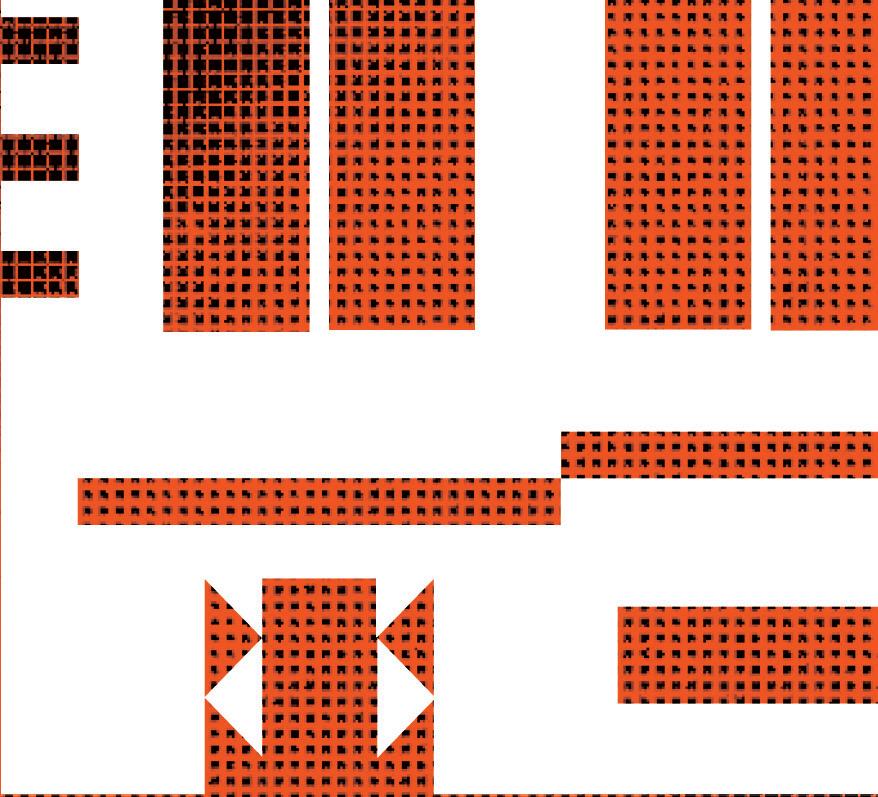


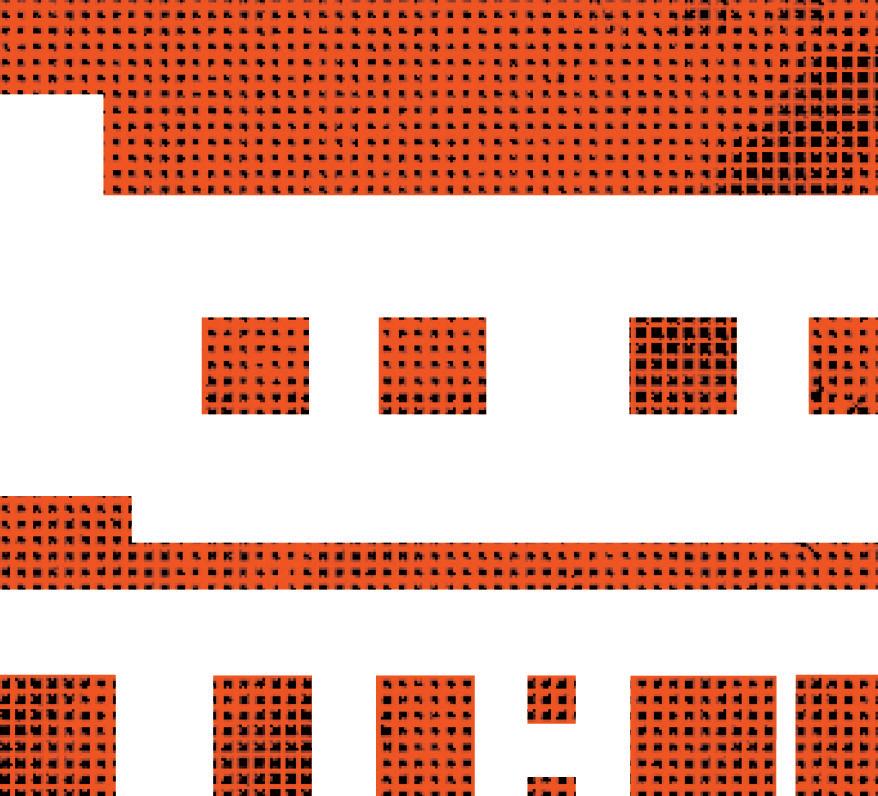
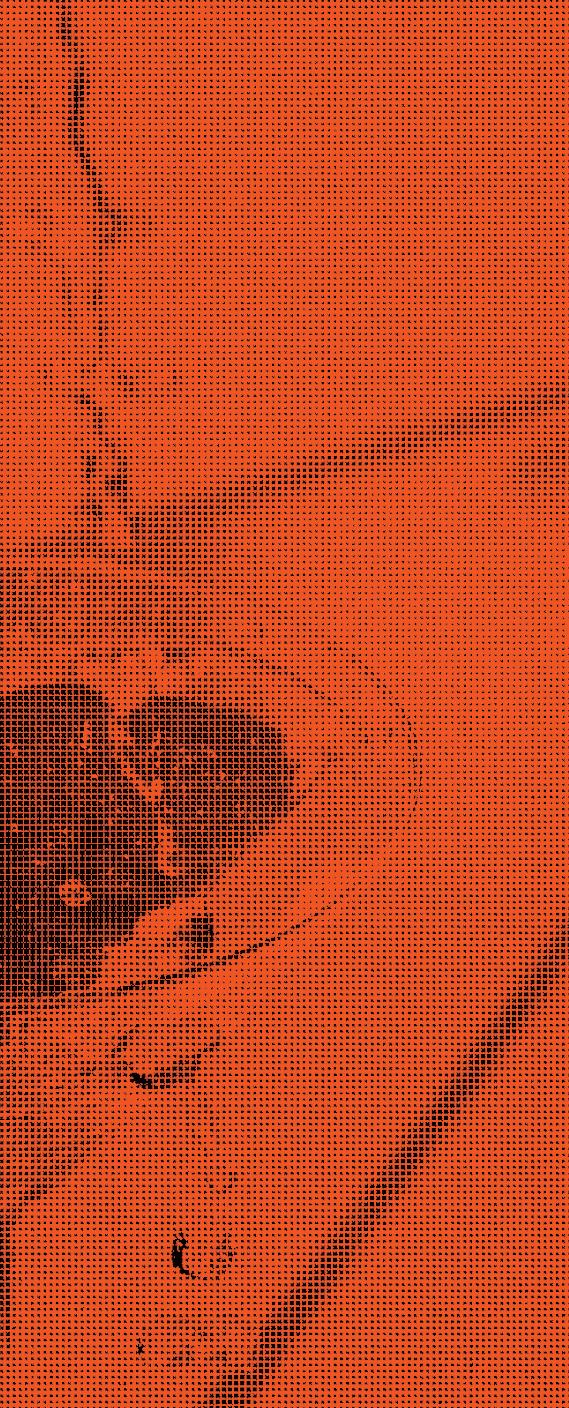

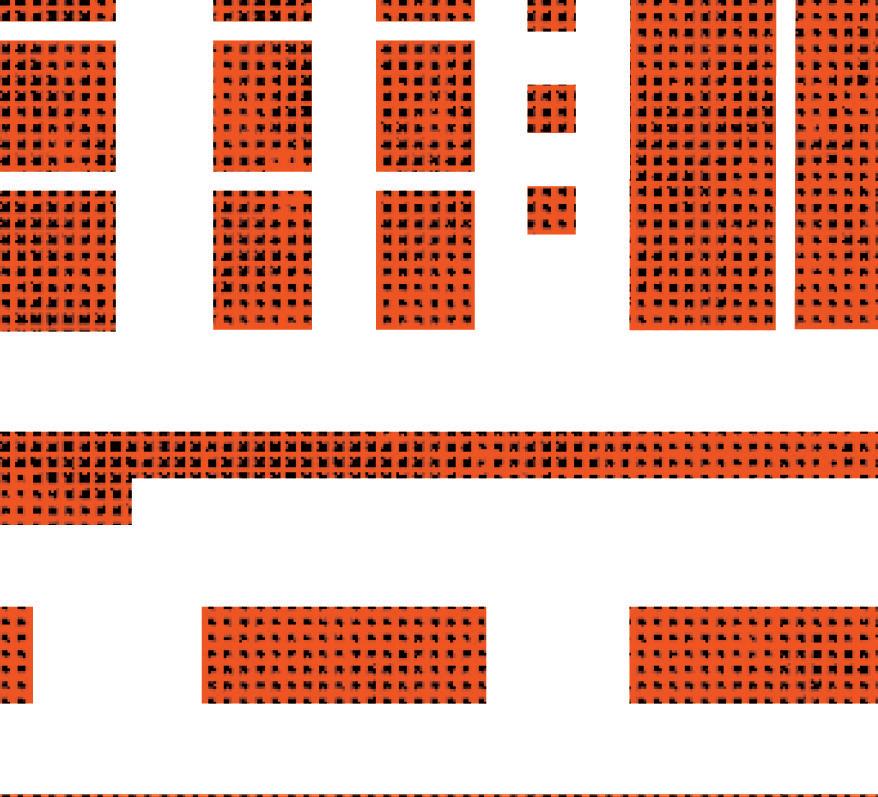
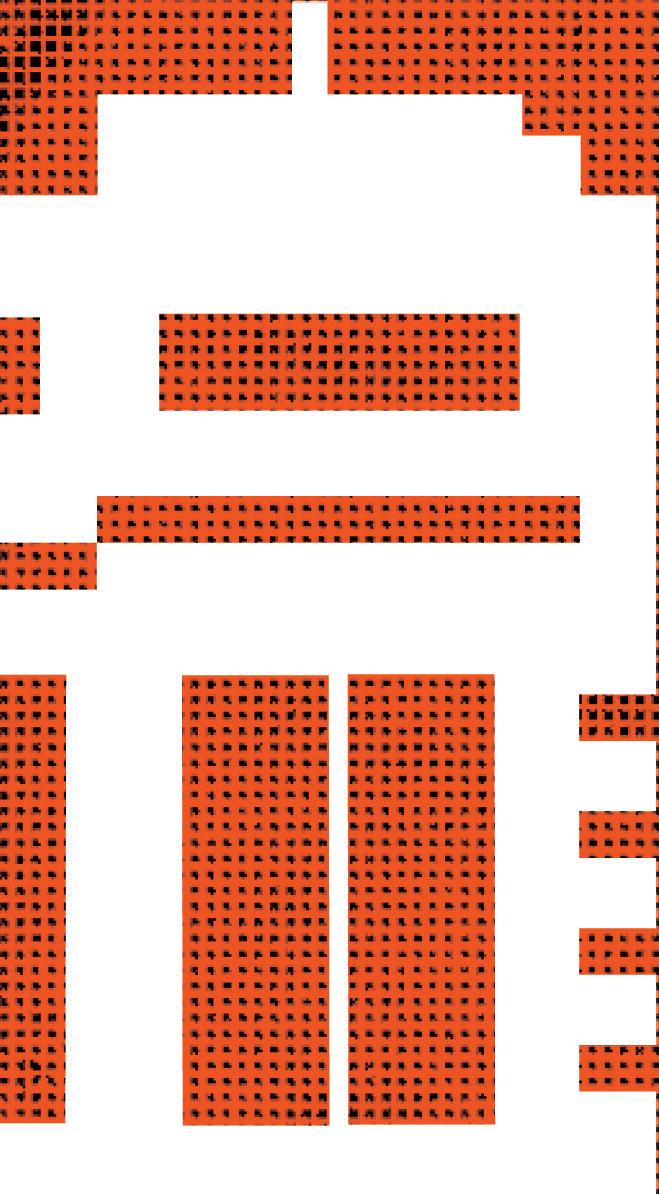
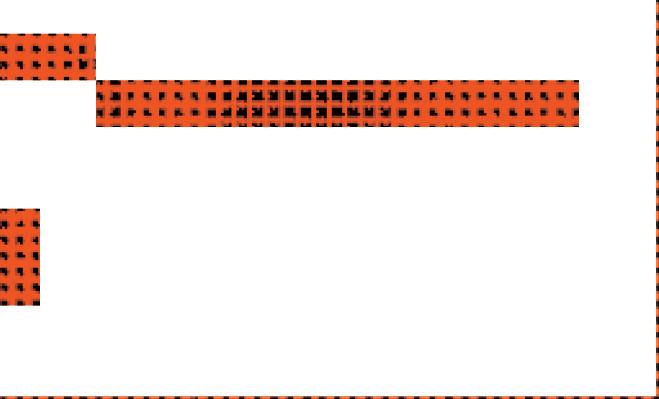

Thank you, for your loyalty, your support and the privilege of your company.
It’s our tenth year birthday celebration and you’re invited to:










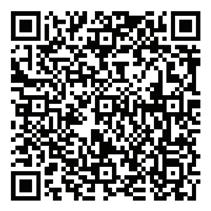

book by SHERIDAN HARBRIDGE & DEAN BRYANT
music by MATHEW FRANK lyrics by DEAN BRYANT
directed by ANNE-LOUISE SARKS
Sybylla Melvyn is finding her voice.
Growing up in the 90s – the 1890s, that is – life doesn’t throw a lot of options at a girl. But life didn’t reckon on Sybylla. Forced to choose between romance and her own genius, her family and a future she defines, she’s decided she’s having it all.
Starring Kala Gare (SIX), Miles Franklin’s novel My Brilliant Career gets a bold new makeover that transforms one of the most enduring literary figures into a musical heroine for this very moment.
7 NOV — 18 DEC


21–27 OCT





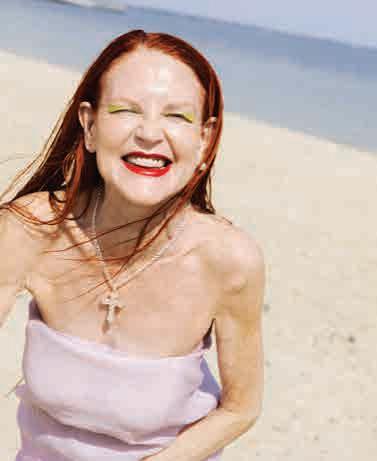
The first issue of Fashion Journal from 1991 is buried somewhere deep among stacks of plastic-wrapped piles in our office. These piles, full of magazines turned sepia over time, are a visual reminder of the many issues that have preceded this one and the many people who have brought them to life.
In its 33 years of publication, Fashion Journal has seen many variations, iterations and departures. Some editions bear the title Fashion Quarterly, one personal favourite has foregone the traditional format of a cover model, opting instead to place a photo of a woman’s nipple on the front. These 194 issues of Fashion Journal are wildly different but all share a common thread: all are free, and all highlight the brilliant talent that continues to emerge like a wellspring in our industry.
This edition is far from our debut but after an almost five-year hiatus, it certainly feels like one. It’s a statement of who we are now: the culmination of who we’ve grown to be since we launched in the early ’90s, but also since we halted print production during Covid and squared our focus to fashionjournal.com.au.
It took many hands, and we acknowledge the Traditional Owners of Country across the many, many lands on which this issue was made. Their rich history of storytelling inspires our contributors and wider creative industry, and we pay our respects to Elders past and present.
I also acknowledge the many editors before me who shaped Fashion Journal into what it is today, as well as the creative and clever team I work with now. Because of them, in these pages, you’ll find a cover shoot that heroes pre-loved fashion, reflecting how a growing number of Australians
Managing Editor
Giulia Brugliera
Features Editor
Lara Daly
Assistant Editor
Daisy Henry
Designer
Kelly Lim
Distribution
and Accounts
Frances Thompson
Managing Director
Kris Furst
Founder
Rob Furst
Contributors
Nina Fitzgerald, Maggie Zhou, Kyle Archie Knight, Bianca O’Neill, Nina Abrahams, Cait Emma Burke, Maryel Sousa, Lekhena Porter, Zebe Haupt, Niamh Galea, Mia Kidis, Verity Mackey, Catherine Conlan, Kaylene Milner, Kirsty Barros, Millie Savage, Imogen Wilson, Honor Munro, Sarah Adamson, Tegan Whittaker, Mindwell Holcomb, Suleiman Thomas, Jasmine Knights, Ava Iacobucci, Elena Dudina, Hannah Baum, Jess Brohier, Juliana Schaller, Josep Velasquez, Joss Newton, Kristian Gunn, Jordan Hallewell, Molly Taylor, Mathew Templeton, Robyn Daly, Hannah Nikkelson, Jamie Kondilis, Erika Geraerts
Enquiries, thoughts and ideas submissions@fashionjournal.com.au
Visit us at fashionjournal.com.au Join us at @fashionjournalmagazine
are coming to dress. You’ll find a beauty editorial with no retouching of the model’s skin because Carol, a fan of Fashion Journal since before most of our team were born, is radiant without it. You’ll find the voices of many women who have found joy in moving up a dress size, and those who are continuing to question how they’re consuming fashion. You’ll find love letters to local designers, written by their peers, in a heartwarming chain of admiration.
We hope this issue opens the floodgates to even more creative eyes and diverse voices. If you’re just now taking your first steps into the fashion industry, welcome. We want to hear from you and see what you can do, please find our email below.
This issue is released as we step into Melbourne Fashion Week but its contents are intended to endure well beyond. Keep this magazine, treasure it, share it with your friends. Put it on your coffee table at home. Come back to it in five, 10, 50 years’ time to see a time capsule of Australian fashion in this moment. That’s what magazines are for.
We hope you enjoy reading this as much as we’ve loved making it.
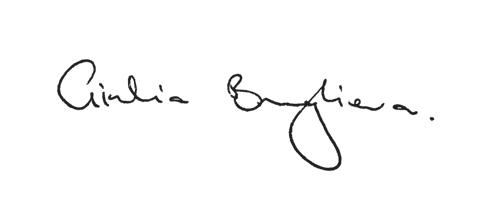
Giulia Brugliera Managing Editor
Fashion Journal is free and distributed to hundreds of locations around Melbourne and Sydney that we hope you frequent and stumble upon. To enquire about having Fashion Journal distributed at your business, please email distribution@furstmedia.com.au
For advertising, content or commercial partnerships please email advertise@ fashionjournal.com.au
Advertising and Partnerships Manager Molly Griffin
Partnerships and Campaign Executive Georgina Woolcock
Fashion Journal is printed in Australia using vegetable-based inks on FSC® Mix certified paper manufactured by an ISO14001 certified mill. Our paper is certified and audited as coming from recycled sources and forests using sustainable tree farming practices
We acknowledge the Wurundjeri Woi Wurrung and Bunurong people of the Kulin Nation as the traditional custodians of the lands on which we largely live and work. We recognise that sovereignty was never ceded and pay respect to Elders past and present
Fashion Journal is published by Furst Media Pty Ltd
ABN 22 111 248 045
© Furst Media Pty Ltd 2024
October 2024


Curated by Nina Fitzgerald
Spotting the most exciting and original designers in the ever-changing fashion landscape requires a certain type of alchemy, one that Nina Fitzgerald has an eye for. A proud Aboriginal and Torres Strait Islander woman, Nina is a creative director based in Darwin. She runs multidisciplinary creative space, Laundry Gallery, creative studio and consultancy, Going North and recently, she opened the doors to Printshop NT, a screenprinting and textile manufacturing hub that’s entirely Indigenous-owned and the first of its kind. As someone with deep roots in both the fashion and art landscapes, we were curious to know what she has on her radar.
I love Jordan Gogos for the imaginative and out-of-this-world pieces he is creating, and the shows he has delivered. Also, Alémais always has such a fun, vibrant and creative take on fashion. Lesleigh Jermanus is a powerhouse and a beautiful soul and I am inspired by the work she does, it just makes you smile.
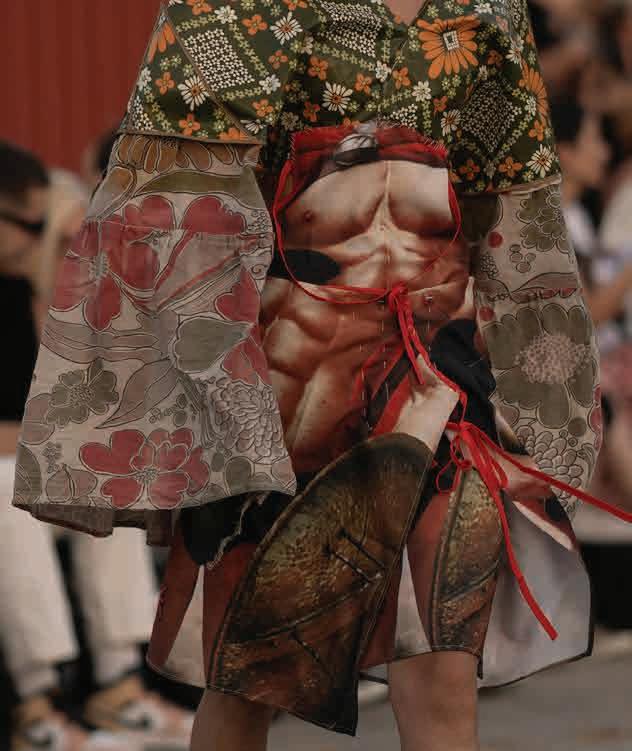

St. Agni is a staple, the brand has the most beautiful quality garments. So much of my wardrobe is Lee Mathews, they’re such gorgeous and reliable pieces, I know the fit and I love the quality. Ellery is, of course, a forever favourite of mine. I hunt for pieces on Depop (Kym, the creative director, is a genius).
If you check out one thing from my list, let it be this. Love Well is impeccable vintage and antique jewellery sourced from across the world – it’s honestly incredible. I love that each piece has a history and a story. The jewellery that curator Emrys Cousins finds always blows my mind.

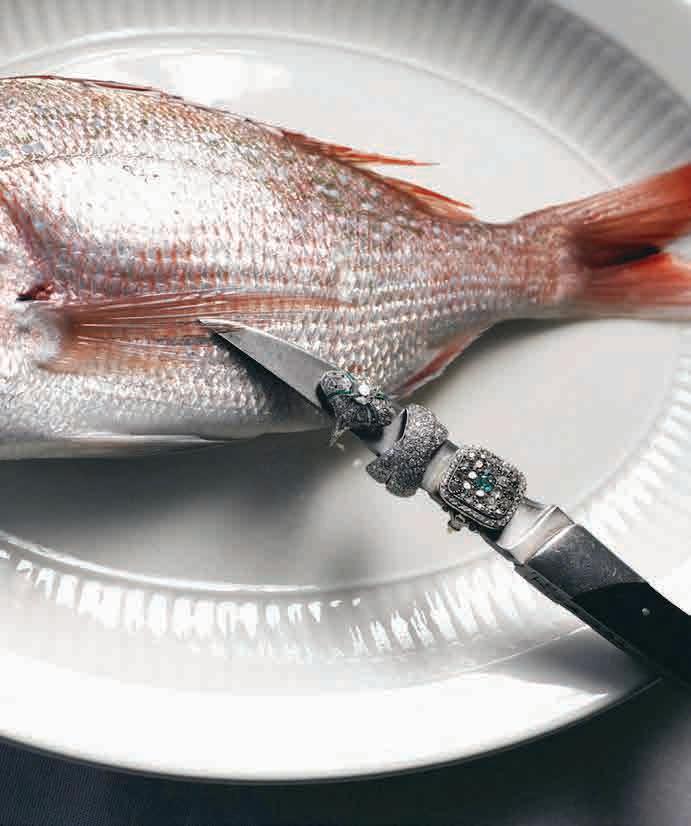
I know we’re coming into summer down south and I always come back to Aussie label Matteau for quality dresses. They’re perfect for Darwin’s year-long summer.
If you’re in your wedding era, take a look at Lola Varma, the Australian bridalwear label from the divine Courtney Illfield. Her vision and her style for the brand are inspiring, I absolutely love what she does.
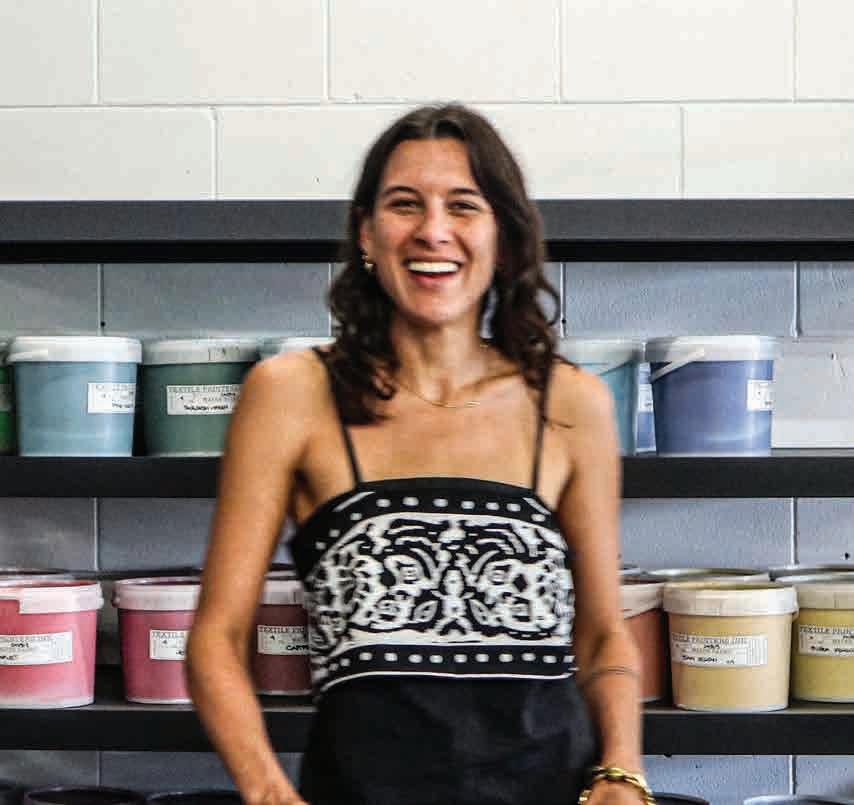

I’m working with some master weavers from Peppimenarti and other regions in remote Northern Territory, learning about their natural dyes and how we can expand the use of natural dyes in the Australian textile industry. We’ve also just launched a screen printing and textile hub here on Larrakia Country in Darwin, called Printshop NT. Watch this space!

After new research revealed that Australians are the biggest fashion consumers in the world, we asked Aussie women: What exactly are you buying, and why?
Earlier this year, we heard the news that Australians had surpassed US shoppers to become the biggest consumers of fashion in the world. According to the report from The Australia Institute, we’re buying an average of 56 clothing items per year. If it sounds like a lot, that’s because it is. But when you really break it down, say to an item per week or four items per month, I think many of us would be guilty of consuming at that rate at some time in the past year. I mean, personally, in the past, I’ve bought four or five items in one shopping expedition alone.
But with a cost-of-living crisis looming over our heads and local retailers saying times are tough, who exactly is buying at this rate and where exactly are they shopping?
The ‘average’ Australian
When Sophie Dawson, a 33-year-old engineer and stylist from Melbourne, heard I was looking for people to interview who fit the average mould of purchasing over 50 items per year, she was surprised to find she was right on target. “I thought that I probably shopped less than average, but I looked at the clothing that I’d bought this year and it was about 25 items by July, which would mean I’m exactly on average,” she says, though she adds a caveat. “I think I’ve bought more clothes this year than I would normally because my shape and size have changed, so a few of my existing clothes no longer fit.”
Redeeming Sophie’s consumption habits further is the fact that most of her purchases this year have been secondhand, sourced from op shops, luxury resale sites or consignment stores like Swop and Goodbyes. “Maybe six or seven items are new, and they were from
sample sales. I tend to avoid fast fashion.”
Instead, Sophie tries to buy from local and sustainable designers where possible. Three of her new tops were from Arnsdorf’s closing sale, one shirt was from Worn for Good (supporting not-for-profit organisation, Dressed for Success) and a handful were from a Skin and Threads sample sale.
Emma Rumble, a 26-year-old arts professional and musician from Melbourne, was also surprised that she fit the profile of the average Australian consumer. She admits to feeling some guilt about her 50-plus clothing purchases per year, even though, like Sophie, most were secondhand.
“I feel guilty saying that I definitely fall above the 50-item-per-year average, but win myself back in saying the majority of the clothes I buy are from op shops,” says Emma. “I’ve always loved shopping and fashion, even as a young kid… I get a bit of a rush finding something in an op shop, and love how my wardrobe is made up of really fun and unique pieces.”
She guesses that at least 80 per cent of her wardrobe is pre-loved, with the remainder largely from local designers like Handsom, Kowtow and Alpha60. “I still buy basics from Uniqlo, but I wear them until they’re absolutely dead and then fabric-recycle them. I’m also conscious of buying natural materials, steering clear of polyesters, acrylics, etc.”
It goes without saying that both Emma and Sophie sit on the ‘good’ end of the spectrum. While still buying a lot of clothing, shopping secondhand means their environmental impact is significantly less than Australians who may be buying at similar rates from fast fashion brands. Even their new purchases are
decidedly more feel-good. Most are from small-scale, local designers who show a commitment to environmental sustainability and traceability of their garments. Plus, these purchases ensure our diverse industry flourishes.
As for the secondhand clothing they buy, data shows a common thread between Emma and Sophie’s shopping habits and the wider Australian population. A nationwide report by RMIT, released just this month, shows that we’re actually buying quite a bit of pre-loved fashion. “Compared to European data, Australians are better at shopping secondhand,” said lead author, Professor Alice Payne, dean of RMIT’s School of Fashion and Textiles. She also confirmed that yes, Australians buy too many clothes.
Both Emma and Sophie have confessed they would like to decrease their consumption. Emma tells me she’d like to utilise her wardrobe more efficiently, so she’s wearing more of the pieces she already owns. Interestingly, Sophie tells me this interview in itself has inspired her to shop less. “Fifty items a year seems like a lot, even if I am on track for that average,” she says. “Now that I have worked that out, I feel like I should stop shopping.”
Why are we buying so many clothes?
Talking to Sophie, it’s interesting to watch her reflect critically, almost philosophically. She asks questions like, “How do we keep things in our wardrobes for longer, and why aren‘t we buying for longevity? Is it inherent in the construction (at every price point) that things don’t last long enough or aren’t affordable to repair?
If we add 50 items to our wardrobes every year, what happens to the things we aren’t wearing?”
Similarly, Emma starts reflecting on her time working in retail, trying to understand what’s driving this widespread behaviour. “It would (and still does) shock me how many people buy items for single occasions… and how many people would throw out clothes after being worn once for that event.”
While that may seem shocking, the rise of ‘clothing hauls’ on TikTok (the term has 50 million posts and counting) and the trend of purchasing themed items specifically for destination holidays could help explain this behaviour.
Emmy-Lou McKean, Marketing Manager at Universal Group, has noticed these one-off purchasing trends filtering down to the buying habits of her customers at brands like Perfect Stranger (the brand offers on-trend womenswear circling the $100 mark). “One item a week, that new stat, I can definitely vouch for that in what we’re seeing our customer buy,” she says.
“The women’s trend cycle is moving so quickly; so much more quickly than men. But I guess, despite the cost-of-living crisis, Perfect Stranger [customers are] still shopping for occasion wear – that is our bread and butter.
I would say she likes to wear something new to special moments in her life. So birthdays, weddings, all of that, she is still coming in every week and going, ‘Okay, I want something new. I’ve seen this [trend online]. What can I get that is similar?’”
With Perfect Stranger’s prices sitting around $100 even for formal and event dresses, that buying behaviour becomes a little easier to understand. As a comparison, if a consumer was instead looking to hire a similar item for a birthday or wedding, they could expect to spend a similar amount, if not more.
breakdown, we can’t say for sure who’s to blame. Working in favour of young Australians, the RMIT report revealed that 18 to 34-year-olds were more likely than older Australians to buy secondhand. At the same time, younger Australians tended to have large collections of unused clothing that were no longer in style. ‘Unused’ is the key word here.
What’s the solution?
In the face of increasing clothing consumption, and the consequences for those countries that bear the brunt of fashion production and waste, France has decided enough is enough. The country has introduced the world’s first ‘fast fashion tax’, adding around $16AUD to every ultra-fast fashion item sold (Shein and Temu fall into this category).
If adopting a similar fast fashion tax here in Australia seems drastic, consider this: Those 56 items per year that we’re consuming? They average out to only $13 per item – a far cry from our runners-up, the US ($24) and the UK ($40). It’s an incredibly low price that may have something to do with the recent news that Australians have surpassed over $2 billion Shein and Temu sales this year. And with local retailers reporting dwindling sales, it’s hard to see how we can ignore drastic measures, like the fast fashion tax, to curb fast fashion spending.
If we add 50 items to our wardrobes every year, what happens to the things we aren’t wearing?
Emma agrees. “Companies need to be held accountable for the sheer volume of stock that is brought into Australia each year. I used to work for a huge global fast fashion brand when I was at uni. Most items came in their own singular plastic bag – truly an eye-opening experience.”
Emmy-Lou, who has seen Perfect Stranger grow from an ecommerce brand to over 15 Australian brick-and-mortar stores in just a few years, says that new social media-led purchasing habits, like the vacation haul, are reflected in their offering. Now, retailers are stocking winter coats alongside swimwear and sundresses all year ’round to cater to a jetsetting clientele.
“We’ve definitely seen that as a trend,” says Emmy-Lou. “That customer is that 21 to 26-year-old girl… and we find they haven’t been as impacted [financially]. They don’t have the mortgages. They’re probably living with friends or at home still. We find they are coming in every week, they’re becoming friends with the store team members. They’re coming in when they know the new product is dropping every week to see what they can buy for the weekend.”
It’s tempting to assume this customer – a woman in her early-to-mid-twenties who’s likely on TikTok – is the driving force behind this statistic. But without a demographic
Sophie, however, believes that a tax is only one piece of the puzzle, with more needing to be done to prop up the industry at home. “I’m not sure if a fast fashion tax will achieve change, but both consumers and businesses being penalised could help us move away from the fast fashion model. Or at least slow the rate of consumption.”
She suggests that tax proceeds could be invested into local technologies to improve traceability of garments, as well as the innovation of renewable materials. “I think [our industry’s] systems need to start incentivising repair, better construction and end-of-life planning.”
One thing is for sure – Australians need to start taking a good, hard look at what we’re buying and who we’re buying from. Will a fast fashion tax deter us from poor-quality $2 tops and push us instead towards slow fashion made by independent Australian designers? Only time, and maybe an additional $16 at the checkout, will tell.
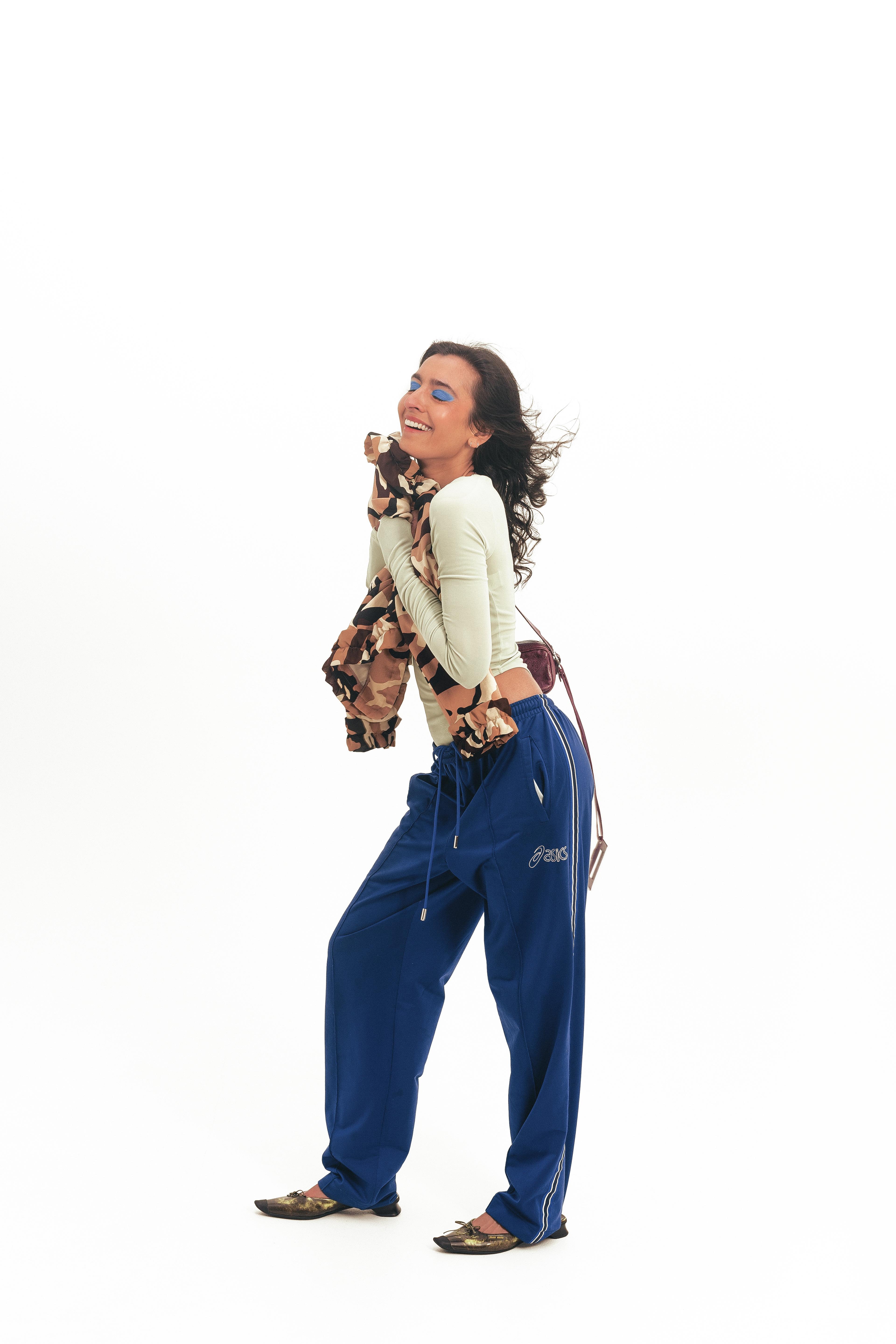

Why do we have such a complicated relationship with being perceived?
Like every other burnt-out, chronically online millennial woman, I spent my formative teenage years on Tumblr, Myspace and the like. I learnt early on that to be a woman on the internet is to be perceived, and that being perceived means being judged.
The value judgements placed on you – by real-life friends, total strangers, a seedy guy you once had a sloppy makeout session with behind the bins at a house party – could range from exclamations of affection to damning assignations of your appearance and character.
I still vividly recall a cute boy commenting on a photo of me on the (now-defunct) social media website, Bebo. “Ew. Not my cup of tea,” he wrote. I was 13 years old, and his dismissal cut like a knife. Unsurprisingly, it was around this age that I developed a complex relationship with being perceived, particularly on the internet. It’s a relationship I’m still untangling today, as a 30-yearold woman.
There have been moments in my life when being perceived in public has sent me spiralling. Simple tasks like going to the supermarket have provoked symptoms similar to a panic attack. Likewise, an unfounded fear that I’m being appraised by strangers and found lacking in some fundamental way has been pervasive.
Being rejected by your group meant certain death, probably through exposure to the harsh elements or a surprise attack by a vicious prehistoric animal. This explains why we still have such intense reactions to perceived rejection, even when undertaking non-life-threatening activities, like leading a presentation at work or interacting on dating apps.
Caroline explains the discomfort many of us feel when being perceived is called the ‘spotlight effect’, which can stem from several social and psychological factors. “The central factor is self-consciousness, which is the state we are in when we’re aware of being watched or judged. We become hyperaware of our own behaviour, appearance and thoughts. This heightened awareness takes us out of the situation we’re in and turns us into observers of ourselves, which can be quite an uncomfortable feeling.”

Increased self-consciousness can make us feel like we aren’t fitting within the social norms that shape how we believe we should behave in public settings, too. “This heightens the pressure to conform to these standards, making us feel uneasy, especially if we think we’re falling short,” says Caroline.
While not everyone’s as chronically anxious as me, I know even the most self-assured among us have hidden a tagged photo. We all hate hearing our voice in the back of someone’s video and for most people, ‘candid’ photos can take up to 20 takes. So why are we so uncomfortable with being perceived?
It’s
Despite being social creatures, being seen has always been a little terrifying for us humans. The fact that public speaking is our most common phobia (ahead of literally dying) is a testament to this. But with our need to be social an evolutionary imperative, why are we so afraid of being in the public eye?
Clinical psychologist Caroline Weinstein tells me this fear may be closely tied to our need to belong. “Humans are social creatures and historically, being part of a group was crucial for survival. Being judged or rejected by a group could lead to social exclusion, which was a significant threat to survival. This discomfort may be an evolved response to potential social threats.”
“Ultimately, the discomfort of being perceived is a complex mix of personal insecurities, social conditioning and the innate human need for acceptance and belonging.”
Curation and control
Living in a digital world, where hyper-realistic filters with names like ‘Bold Glamour’ are only a tap away, we now have an unthinkable level of control over how others perceive us. Using the many tools at our disposal to perfect what we post may boost our confidence, but it can also amplify the insecurities that arise when we don’t have control over our image.
Our fear of being tagged in (or even seeing) an unflattering photo of ourselves runs deep. But buying into this fear can have real-world ramifications. It might stop you from selfpromoting your successes, ultimately hindering your career. It might stop you from capturing happy holiday moments, going for runs in public, dressing how you want or – like Fashion Journal’s Managing Editor, Giulia Brugliera – it could have you entertaining the idea of a ‘no photos’ wedding.
I’ve known friends who never post anything on social media, despite wanting to, for fear of being perceived the
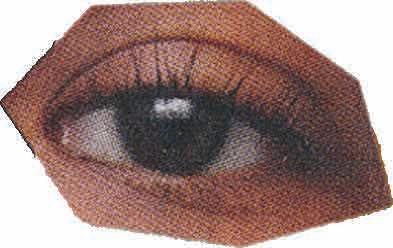
wrong way. One friend went as far as to refuse being in a single photo on a four-month trip with her partner because seeing photos of herself causes her that much anguish. She tells me that she laments this decision, saying, “We’ve now lost all those memories”.
As a writer and creative, self-promotion is basically built into my job. Despite this, during the almost five years I spent as the editor of Fashion Journal, outside of what I shared on FJ and its social platforms (which was, admittedly, a fair bit) I did minimal self-promotion.
When I started freelancing this year, I began sharing more of my work online and I’ve seen my follower count, engagement and career opportunities flourish. The downside is, I’m often overcome with an all-encompassing feeling of humiliation. The idea of a man I’m dating reading my articles about long-term singledom, or reviewing my Instagram profile and finding it ‘cringey’, fills me with dread.
For anyone who struggles to share their work online, Caroline believes the key is finding a balance between visibility and personal comfort.
“First, decide what to share – you don’t have to share everything online! Be selective about the personal information and types of content you put out. Focus on your work, projects and achievements, while keeping private anything you might feel will attract too much judgement, if that feels more comfortable.”
If blending the personal and professional still makes you uneasy, she suggests creating separate accounts. “This allows you to control the narrative in your professional space while keeping your personal life offline.”
Another tactic to try is creating a content schedule and potentially automating your posts. This can make posting updates feel more like a routine, instead of something you’re always thinking about.
“Ultimately, it’s a complex mix of personal insecurities, social conditioning and the innate human need for acceptance.”

Unfortunately, the payoff from sharing my career milestones is too lucrative to give up. So how do I navigate it? Content creator and fellow writer, Maggie Zhou, tells me my read on the situation is probably overblown. As someone who’s been influencing since before there was a name for it, she’s clearly got a grip on being perceived.
“I don’t really give two hoots about who watches my videos or reads my writing. It’s nice to publish stuff online because, in a way, it creates a separation; it doesn’t really feel real,” she says.
“Whenever I see someone sharing their art or work online, my knee-jerk reaction is positive. We don’t scroll our For You page criticising and cringeing at people who’ve chosen to share online. Give yourself some compassion, and also, no one actually cares that much about you.”
Who you engage with online can enhance your experience of being perceived, too. “Surround yourself with like-minded people who are also in creative fields [or whatever your industry]. Engaging with a supportive, niche community can reduce the anxiety of being seen by a large, unknown audience,” Caroline says.
And finally, just as Maggie suggests, Caroline tells me it’s important to practice self-compassion. “A key part of dealing with perception anxiety is to acknowledge the discomfort. Understand that it’s okay to feel uncomfortable, and this is part and parcel of being online. Over time, ongoing exposure to these experiences can reduce anxiety and build confidence.
“Each time you successfully share a post or receive positive feedback, acknowledge it as a step forward. Over time, these small wins can help desensitise the fear of being perceived.”

Fashion writer Maggie Zhou has the kind of career that makes you want to trap her in conversation at a dinner party. Presented by

Have you ever stalked someone on LinkedIn and wondered how they managed to land that wildly impressive job? While social media might have us believe that our ideal role is a mere pipe dream, the individuals with these titles were, believe it or not, in the same position once, fantasising over someone else’s seemingly unattainable job.
WORDS BY GIULIA BRUGLIERA PHOTOGRAPHY BY ZEBE HAUPT
Behind the awe-inspiring position descriptions and the fancy work events lies a heck of a lot of hard work. So what lessons have been learnt and what skills have proved invaluable in getting them from daydreaming about success to actually being at the top of their industry? Introducing How I Got Here, a series we’ve been running online at Fashion Journal for quite some time now. Through the lens of the women whose work we admire most, we explore the peaks and pits, the failures and the wins, and most importantly the knowledge, advice and practical tips gleaned along the way to the industry’s dream jobs.
Maggie Zhou felt like a fitting candidate for the first iteration of How I Got Here in a printed format. Not because the sustainable fashion writer cut her teeth in print magazines – quite the opposite, Maggie came of age during the digital turn of the industry. She was raised by the internet in a way, starting with Twitter and Tumblr in her tweens, then Instagram and Wordpress blogs in her teens. I’ve never seen anyone make friends on the internet quite like Maggie, she has almost every relevant content creator in her DMs.
The profile she spent years building online soon led to a series of internships (including one at Fashion Journal) which were the springboard into a career in media.
She’s the quintessential ‘media girlie’, a title that rings especially true for Maggie because she wears so many hats. She’s a sustainable fashion writer, yes, but she’s also a podcaster, content creator
(a term she prefers over ‘influencer’) and brilliant conversationalist, often cherry picked to host panel talks and roundtables at industry events. While her interests span well beyond sustainable fashion, it’s a common thread throughout much of her work.
I often marvel at Maggie’s ability to juggle so much with ease and grace. I’ve worked with her in many different capacities over the years and I’ve never seen her miss a deadline or break a sweat – a truly remarkable feat in the fast-paced world of media. When I ask how she does it all, she credits apps for helping her streamline her workload (again, she’s a true digital native). She uses Xero for invoices, Monday for active jobs, Notion for tracking tasks and Up to simplify her finances. Being able to see her income and expenses grouped in Up means she can free up head space to focus on other priorities, like developing her creativity and relationships.
Maggie entered the industry as an outsider knowing nobody. Her focus on relationships, combined with her willingness to work hard and value her own worth, has helped build her enviable freelance career to date – with many lessons learnt along the way.
Hi Maggie! Tell us about yourself, what exactly is it that you ‘do’?
Hello! I’m a freelance writer, content creator and podcaster. I predominately write first-person opinion pieces for lifestyle publications about fashion, life, culture and health (and create social media content about these topics too). I also co-host a pop culture podcast called Culture Club, alongside my friend and fellow writer and editor, Jasmine Wallis.
Take us back to the early days of your career. Did you start with study or dive straight into work?
If I’m honest, this pathway probably started in my tweens around 2011 when I was in the throes of One Direction fandom. That’s where my social media obsession began: on my family computer, using Twitter as a means to make members of the British boy band fall in love with me (reader, this proved to be unsuccessful). For a few fruitful years, I was part of a flourishing global community of mostly teenage girls, becoming fluent in internet slang and meme culture.
Around the same time, I stumbled onto the microblogging platform Tumblr, which proved to be pivotal education for my pop culture knowledge, visual language and style. I then joined Instagram at the start of 2013, posting outfit photos and ’grammable pics. That one’s stuck: over a decade later and I’m still doing the same.
I also started a Wordpress blog to share fashion photoshoots I forced my mum and sister to capture, accompanied by diary-like text and fashion musings. I dive into my internet records because I firmly believe it’s been so crucial in moulding my interests and skill set. It led me to complete a double bachelor’s degree in communication design and media communications (specialising in journalism) at Monash University. During that time, I also undertook four unpaid internships: one doing marketing at a food-based tech app, and the others in writer positions at Broadsheet, Cocktail Revolution and Fashion Journal.
In 2021, in my final semester of uni, I landed the position of Writer and Producer (before becoming Wellness and Living Writer) at Refinery29 Australia. Being part of a national launch for a global brand was unbelievably exciting and truly a once-in-alifetime opportunity.
At the start of 2023, I became Fashion Journal’s Branded Content and Features Editor. There’s a saying we have: “Once an FJ girl, always an FJ girl.” I interned at Fashion Journal back in 2020, worked as an editorial assistant at the start of 2021 and then returned as an editor for a year. FJ’s home to some of the smartest, funniest and sweetest women, and I’m proud to be an FJ girl for life.

I bit the freelance bullet this year and now make my money from sponsored social media content, written feature articles, speaking gigs and podcast sponsorships.
What hurdles have you faced getting to where you are now?
It’s both a source of pride and a chip on my shoulder that I entered this industry knowing nobody, with no leg up or person to lean on. Perhaps because of this (and the fact that I came up at a time when oversharing on the internet as a woman was à la mode), I felt like I had to mine my identity for content. It was a mix of feeling not good enough, feeling ‘lucky to be here’ and having to prove my worth through excavating my marginalised identities. Whether that be for campaigns, projects or jobs, I’ve constantly struggled with feeling tokenised.
I never allowed myself to entertain the idea of a career in media. It wasn’t until I was a few months into my first full-time writer role that I realised I was living a dream I hadn’t allowed myself to have. It’s tiresome to point out how white-washed Australia’s media industry is, but it’s definitely why my imposter syndrome was pretty all-consuming at the start of my career.
I now recognise the many privileges I have, as well as the hurdles I also face as a woman of colour. I back myself much more now. Screw tall poppy syndrome and having to be grateful and humble to a fault: I believe in my worth and what I do.
What do you want people to know about the industry and what you do?
The influencing and media world is lucrative, finicky and tumultuous. It’s glamorous too (events, PR packages and trips, there are so many perks to the job). I cringe when I hear creators moan about how hard it is. Like, go work a double night shift as a nurse and see who’s complaining!
But a cost of the industry I’m learning more about is the toll of commodifying yourself. My thoughts, interests and appearance don’t feel solely my own. Of course, I’ve chosen to pursue this as a career (and I love it!) but it’s emphasised the importance of separating myself from my work too. It’s taxing and tiring to base your worth on engagement, numbers and the whim of strangers.
What’s the best part about your work?

Honestly, the access and financial freedom it’s afforded me. Is that crass to say? I’ve watched my parents work extremely hard all their lives and I know what a strain money can be. To do what I love and feel fairly compensated for it is what I ask for from a job.
I’d be remiss not to mention the beautiful, incredible and delightful circle of friends my work has led me to also. These women make me smarter and sillier.
What would surprise people about your work?
A lot of creative thinking – whether that be for article writing or content brainstorming – happens when you’re doing nothing. These ‘nothing’ moments, like taking a shower, going on a walk or doing the dishes, are instrumental for creativity. Being bored is a gift. It’s easy to outsource distraction, so sit in your boredom and savour that discomfort.
How do you juggle all your deadlines, personal projects and business admin without dropping a ball?
I love being organised! It makes my brain feel good. I love handing in assignments earlier than the deadline, colour-coding my Google calendar and ticking off to-do lists. A priority of mine since going freelance is making the most of smart, digital apps that streamline processes for me. I use Xero for invoices, Up for finances, Monday for active jobs and Notion for tracking tasks. Being able to see all my income and expenses grouped in Up means I can free up my head space to focus on the creative stuff.
What skills have served you well in your industry?
Being personable, warm and nice! These may sound dull but in an industry where it is about who you know, people who are genuinely friendly and enjoyable to be around are much more likely to go far. Be the person who admits it when they don’t understand something, or pulls someone being left out back into a conversation.
What advice would you give to someone who wants a career like yours someday?
Why do you want it? No seriously, why? The job titles of writer, editor and influencer are often put on a pedestal, usually because of their shiny, glitzy perks, not because of the jobs themselves. Are you pursuing this career for your ego, for the social media announcement post, for the accolades and recognition, or the free stuff?
I think you actually have to really enjoy the process of creation to have a long, fulfilling career in media. I love the process of writing, it reminds me of assembling a puzzle. I love research and I love interviewing people. I love filming and editing video content. Make for the sake of making; write for yourself, make content for yourself.
What about a practical tip?
Meet deadlines. Be a go-getter, ask questions and then ask more questions. Crave feedback, read widely and edit your own work. Don’t read the comments. And when you inevitably do read the comments, don’t take them too personally. And see an accountant.
This article was made in partnership with Up. up.com.au
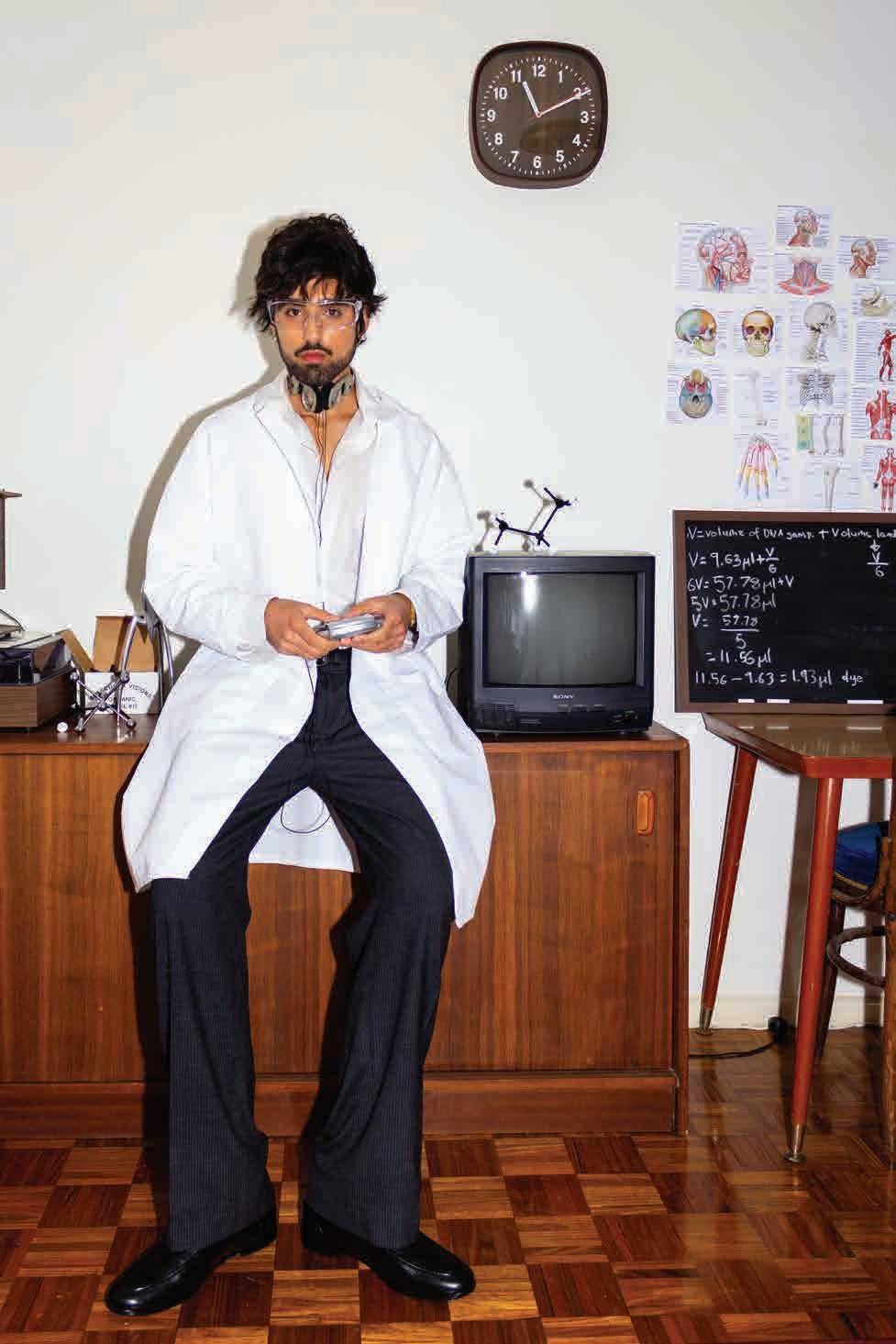
Tarik Junaid Ismat reflects on his relationship with fashion, starting with his most treasured wardrobe item, a lab coat.
My introduction to the fashion industry started when my partner Kyle (a photographer) got this amazing opportunity to work at Melbourne Fashion Festival.
I’d never heard of it, I’d never seen a runway in my entire life. All I knew was Gucci and that was about it. I love to do new things that are terrifying, so I volunteered. It was so thrilling. After the runway, I went backstage and I was so happy. This woman standing in the doorway says, “I saw you out there, have you ever thought about modelling?” It’s so strange that the fashion industry is something so prominent in my life, yet there’s this contrast that I’m building. I want to be a doctor and I want to work in science. It’s such a contrast to the fashion industry.
I’ve been thinking about my most important piece of clothing and it honestly might be my lab coat. I know it’s not very fashion-related but it’s quite important to me. It inspires me to find out more about myself and find out more about the world. It’s a reminder to keep challenging myself.
I used to have an inquisitive relationship with my clothing. Now, I need clothes that I’m comfortable in, that I know look good on me. Some people are really comfortable in plain clothing. Some people are comfortable wearing high heels every day and extravagant clothes with a lot of flair and colour. Comfortable for me is a T-shirt or a button-up and a blazer, some jeans or pleated pants, and some loafers.
It’s strange because although I’m quite young, and spend most of my time at university surrounded by other young people, I would say that I dress a lot ‘older’ than most.
I don’t really see anyone else wearing blazers and loafers to university. I really don’t see myself as fashionable, though, nothing that I wear is that daring. I’m not trying to ‘do’ anything or, like, curate an outfit. I just like my clothes, they feel like home.
I had to take a lot of fashion risks to get here. I experimented with clothing a lot in my teen years. I was cutting the sleeves off my clothes to wear as singlets when I thought that I was punk (I very much was not punk at all). I went through a bit of a ’70s phase wearing a lot of flares and colourful floral prints. Then I had a moment wearing a lot more feminine clothes, getting comfortable wearing high heels, sometimes skirts. And you know, even though I don’t dress like that anymore, I never regret any of the fashion decisions I’ve made because I wouldn’t be who I am today.
I never used to like the term ‘capsule wardrobe’ at all. I grew up poor and I was just like, ‘Well, like, I had a capsule wardrobe’. Growing up, this isn’t revolutionary. Then, obviously, as I explored fashion, I accumulated so many clothes. I was just exploring so much and trying all these new things and then, you know, not really wearing them again. And then, you know what? I did go back to a capsule wardrobe.
I’m Aboriginal, but I don’t really look that Aboriginal. I’m Pakistani, but I don’t really look that Pakistani. I’m a queer person, but I don’t really look that queer. And I’m a man, but maybe I look a little bit too feminine, but then not feminine enough, and then not masculine enough either. I can’t be put into a box. I just look like myself and I’m very comfortable with myself. I don’t feel the need to change who I am.



It’s not often a creative talent comes along who can catch the eye of the fashion industry on both sides of the lens. But Kostantina Vlahos’ allure as muse and maker is proving irresistible.
AS TOLD TO FASHION JOURNAL
PHOTOGRAPHY BY
KOSTANTINA VLAHOS
There’s a concept in creative industries called the ‘eye’. It’s intangible, nebulous, not something that can be taught. You can hone it, sure, but you either have it or you don’t. It may be an eye for design, for photography, for styling or for knowing what a creative team wants when posing in front of the camera. In the case of Kostantina Vlahos, it’s all of the above.
Now focused on her work in photography and creative direction, Kostantina has been dabbling in different corners of the fashion industry for close to a decade. She’s tried her hand at styling, assistant directing and producing across both New York City and Melbourne, where she divides her time. It goes without saying, Kostantina is also insanely beautiful. She draws your eye in a way that compels teams (photographers, casting agents, brands, editors) to put her in front of the camera. It was here, after her modelling career took off, that she knew she wanted to do work on both sides of the lens. Kostantina’s star has been rapidly rising since.
Having been on our radar for years, she shares her take on the allure of the industry, her unexpected muses and what she hopes for the future of Australian fashion.
Growing up, I always romanticised the idea of being in the fashion industry in some capacity. Although I never intended to enter, I was led to it. I picked up a camera as a teenager and quickly realised I wanted
to be a photographer. I went on to study photography and began working as an assistant for other photographers, which introduced me to the fashion world. Photography was my gateway, and I explored various roles, from styling and creative direction to producing, art directing and assistant directing.
I had always wanted to model, and people often told me I should pursue it, but I never really thought it was a possibility. That changed when I was unexpectedly scouted. Once I decided to commit to modelling, the opportunities came flooding in. I realised my true passion is not only in the creative side of the industry but in modelling too.
My biggest inspiration is nature, especially when I’m by the beach. I often meditate there until I channel an idea that resonates with me. As a Pisces, I’m a natural daydreamer, and I often create storylines in my mind. Many of my ideas come to me through these moments of reflection and imagination. Lately, I’ve also been inspired by ’80s Bollywood films and neoclassical architecture, which often align with my cultural roots [as a Greek-Polynesian woman].
Lately, I’ve been centring my work around themes of water, sirens and the mythical and ethereal On a more personal project level, I’ve been drawn to reinterpreting famous historical artworks with a modern twist, like the ‘modern-day Venus’ piece I created. I hope to continue providing representation for people like me and normalise our presence in the industry, ensuring we take up the space we rightfully deserve.
Working both in front of and behind the camera has given me a unique perspective. It’s allowed me to visualise things more clearly and understand how far we can push to achieve a vision. I feel like I give direction much more effectively now, having gained the perspective of a model.
I hope to see more Australian brands embracing inclusive size ranges. Having lived in America, I experienced how accessible fashion can be for plus-size women, but here in Australia, it’s still quite limited. While a few brands cater to wider size ranges, most stores don’t carry anything beyond a size 18, and we’re forced to order online. I hope that brands claiming inclusivity will bring adequate size ranges into stores for us to try on in person.
I hope more brands hire plus-size fit models to truly understand our bodies. Many brands trying to expand their size ranges simply widen the garment, which often leads to shorter lengths and less coverage, instead of adjusting for proper fit. Simple things, like adding enough fabric to maintain proportions, are often overlooked due to a lack of research and care. Sometimes, it feels like inclusivity is more about tokenisation than genuine effort. However, I do see progress, and I believe more growth is on the horizon.
Some incredible creatives doing great work in Australian fashion right now include photographer Jess Brohier, stylists Carlos Mangubat and Jam Baylon, and designers Nicol and Ford and Wackie Ju. These are the people pushing boundaries and putting Australian fashion on the global radar.

CURATED BY GIULIA BRUGLIERA
The fashion industry often gets a bad rap in terms of culture, given its stereotype as a cut-throat industry full of cattiness and Machiavellian manoeuvring. To the contrary, I’ve found the local industry to be a warm and fuzzy place, centred on collaboration and uplifting one another. When talking to anyone who works in fashion, I hear nothing but glowing reviews of their contemporaries. There’s such admiration, awe and respect, as well as a culture of support. It’s a side of fashion not often seen from the outside but internally, it’s palpable. The love is like a web, threading its way across all corners of the industry. It also runs deep in a way that, I think, is best shown through love letters.
Starting with a creative talent I’ve long adored, Sydneybased Niamh Galea of Ramp Tramp Tramp Stamp, I asked her to write a love letter to someone she admires. I then asked her addressee to do the same. It’s a daisy chain of love letters, so to speak.





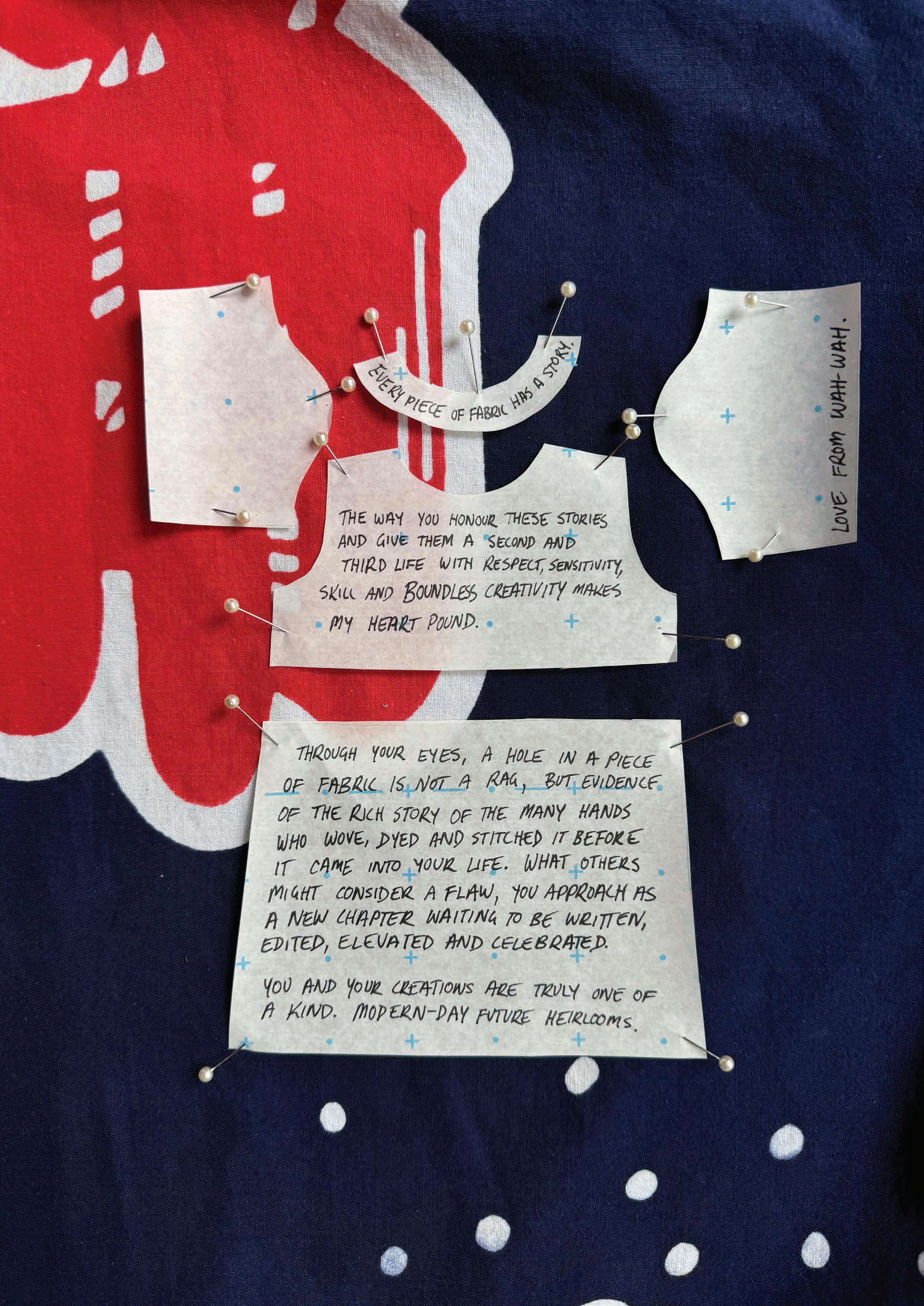


Meet those outside the dressing room helping you buy better.



Assistant store manager
“We have customers come in and say, ‘Oh, it’s so refreshing to see a male working here! How do you find wearing the clothes?’ I think my presence is breaking a stigma for people in terms of androgynous dressing. It’s really freeing to be a part of that because I don’t think clothing needs to be so masculine or so feminine when there is that spectrum. We’ve had men, or non-binary people who are more male-presenting but may not feel that way, and they come in quite timid. We make such an effort to make the space feel warm and the fitting rooms feel welcome because the fashion landscape can be so intimidating.”
Agood sales assistant knows how to read you. They’ll leave you to browse in peace if needed and be there for guidance on fit, size and styling before you even think to ask. A great sales assistant is more akin to a friend. They’ll whisper about upcoming sales, listen intently as you offload trivial gripes about work and exes, and offer emotional support as you blink back tears under the regretful downlight of a changing room.
Of course, not every client is the friendliest, and the grace, tact and deftness I’ve witnessed across sticky situations in the retail industry is unmatched. The negotiation skills of some store managers would give the country’s politicians a serious run for their money.
Great retail service is an art, practised by all those who work within the industry and perfected by only a few. Those who do it best know there’s much more to it than selling products: style, culture and community are the pillars that drive some of the country’s best retail spaces. It’s certainly the case at Emporium Melbourne, which has set the standard for Australian retail since it opened 10 years ago. Here, five of the centre’s sales assistants share the art behind their practice.
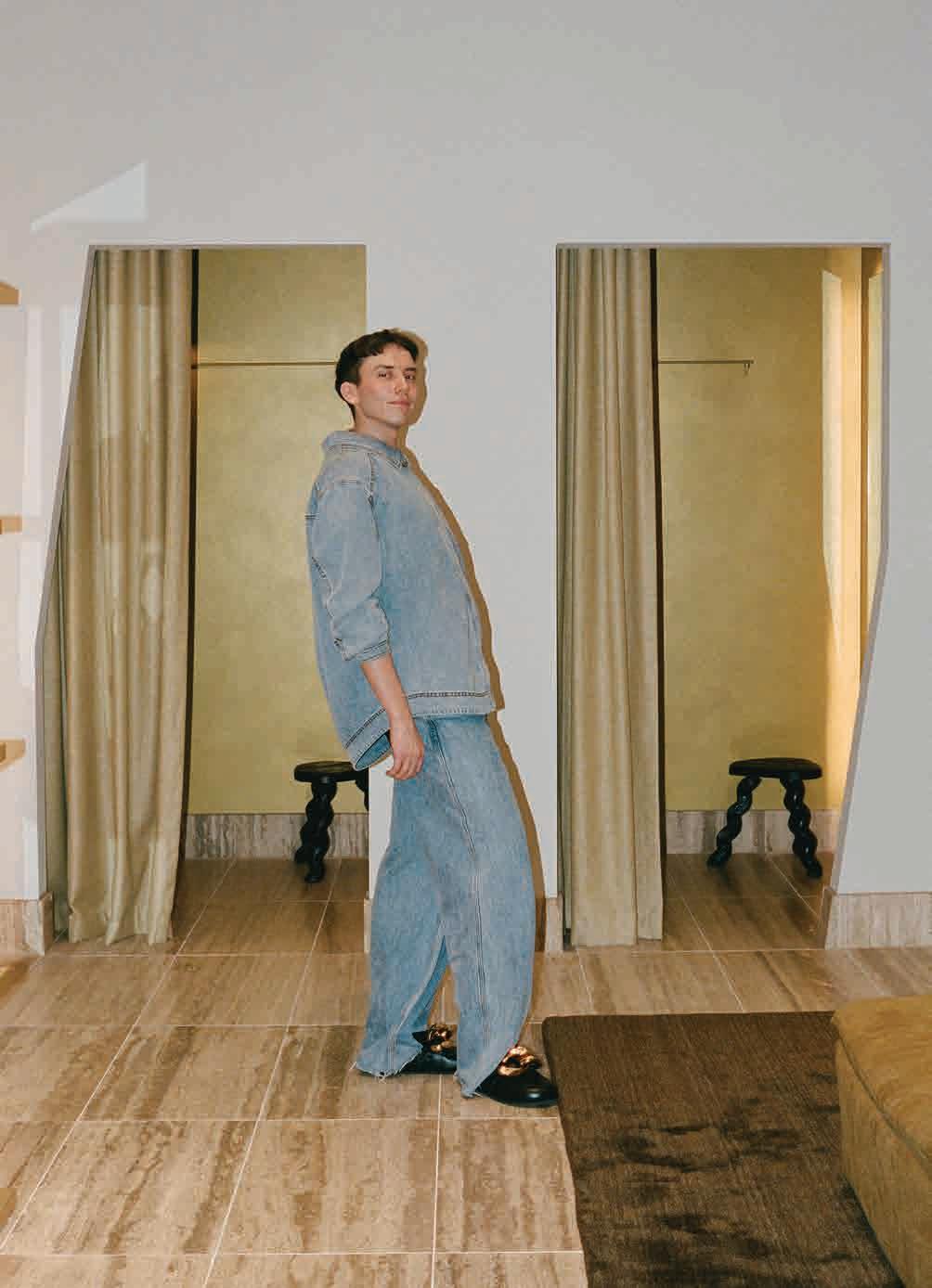
Store manager
“I think people might underestimate the impact we can have on someone’s day or week, or life, depending on the connection you have with the customer in the moment. I think they also underestimate how we can change someone’s idea of style. You can see a customer and assume they dress a certain way, but maybe the way that they actually want to dress is completely different. Seeing what they wear when they come in is always a good indication but there’s more beyond that. Getting to know what they feel confident in, and what sort of textures and fabrics they like, is really important.”


Casual retail assistant
“I like to encourage customers to not be afraid to try. I’ll always ask them first how they feel about trying certain clothes because it’s essential for them to feel comfortable and confident. But I’ll also help them to experiment with different styling and give them ideas on how they can elevate a look, according to what they like. I love giving someone styling ideas because it’s what I’ve been doing since I was a kid. I would style my whole family, it’s always been my hobby.”
Area manager
“Retail isn’t just nine to five, it’s not just one approach. If a person has some time to spend, they like to chat and are inquisitive about playing around with different styles, I will ask a lot of questions. But if they know exactly what they want then I love to let them guide the experience and I can add to that with suggestions. It also depends on the occasion, if they’re after something very specific for a wedding or a party. That’s part of the fun, every customer’s needs are different and no day is ever the same.”


Retail sales assistant
“For me, personally, I come from a design and styling background, which customers may not always expect on the shop floor. I guess they would expect that from someone behind the scenes or in head office, but to get that information on the shop floor is invaluable. I find my customers are surprised by my knowledge and passion about our product – which comes down to even the cut, construction or fibre makeup of the product they’re holding. I love to see the shock in a client’s face when they ask me a question and I can elaborate. It makes them a lot more confident in taking that step and making their purchase.”


Words by Maryel Sousa
Navigating food content online can be a slippery slope if you’re not paying attention.
Content warning: This article contains discussions that may be triggering for those who have experienced disordered eating.
No one would call me a revolutionary for declaring that social media platforms have mutated from their original intention of spaces for connection. Now, they’re fully-fledged marketplaces. As profit-driven businesses, their algorithms are meticulously designed to serve us the ads we’re most likely to fall for and the content that will keep us glued to our screens. Whether we like it or not, algorithms are shaping consumer behaviour and ultimately, shaping us. From the clothes we buy to the food we eat, we live in a world where what we consume is deeply tied to how we see ourselves.
As women, we’re taught that beauty is our most valuable commodity. Social media algorithms can capitalise on this by feeding us content from billion-dollar industries intended to make us feel inadequate. Advertisers and influencers promote products that vow to make our hair glossier, our skin softer, our teeth whiter and our bodies thinner, curvier or more toned. The more we interact with this content, the more of it we see, perpetuating an unending cycle of insecurity.
While the platforms may have changed, this isn’t the first time social media has been used to fuel harmful body ideals and disordered eating. In the 2010s, ‘thinspiration’ Tumblr accounts and pro-anorexia (pro-ana) forums revered thigh gaps and prominent collarbones as if they were moral virtues. A rail-thin body was the ultimate status symbol. It was in this era of the internet that Amelia’s* experience with disordered eating began. This year, she noticed history repeating itself with a twist.
People posting to pro-ana forums in 2014 were honest about their goals – eat less, get skinny. This content was dark and to find it, you’d have to intentionally journey to some pretty dark corners of the web. Now, in the new age of influencers and algorithms, most content creators are smart enough to brand themselves as ‘wellness’ gurus, still serving ‘thinspiration’ without being explicit about it. Instead, they show off their ‘healthy’ meals and ‘clean eating’, framing these habits as self-love. This rebranded version appears more innocuous, but its broader reach and covert nature make it all the more disturbing.
“There’s heaps of content validating disordered eating on social media. It makes recovery harder because it feeds that little voice in your head that wants you to keep starving,”
Amelia says. The constant triggers feel difficult to escape, nudging her towards damaging habits of the past.
She’s not alone. According to the Butterfly Foundation, a national charity supporting Australians living with eating disorders, over two-thirds of Australians have had their body image negatively impacted by social media. Yet, many people can’t seem to break free from the algorithm’s grip, particularly when it comes to food-centric content. Disordered eating behaviour can present itself in subtle, even appealing ways online, which can make it hard to detect and harder to avoid.
frenzy
Food is everywhere on social media. Post-pandemic years have given rise to beauty trends that are nominally delicious – think brownie-glazed lips, blueberry milk nails and caramel latte makeup. In an unpublished excerpt from her Sunday Times article, ‘The rise and rise of ‘dewy dumpling skin’’, American beauty critic Jessica DeFino draws a compelling connection between these food-focused beauty trends and the current state of our diet culture.
The world is idolising thinness again – influencers are reversing their BBLs, weight-loss crazes are causing national Ozempic shortages and the phrase ‘heroin chic’ is unbelievably back in the cultural zeitgeist. Could it be, Jessica wonders, that our craving for an edible appearance stems from our bodies’ unmet desire to feed? Are we searching for new ways to satiate our appetites?
Of course, we’ve become obsessed with food in a more literal sense, too. Whether it’s watching people who eat less than us or those who eat much, much more, we’re fascinated by it. Over the last decade, you’ve almost certainly stumbled upon this type of content. Influencers have revived the What I Eat in a Day format, often preaching the moral goodness of small portions and ‘clean’ ingredients. Meanwhile, mukbang – the foodcasting format imported from South Korea – has surged in popularity, as countless (often slim) creators glut enormous helpings of food for your entertainment. From one extreme to the other, one thing’s for certain: we’re captivated by what other people consume. But why?
Melissa Wilton, Head of Communications and Engagement at the Butterfly Foundation, suggests that we’re attracted to What I Eat in a Day videos because in them, we think we may finally learn what it takes to reach society’s impossible beauty standards.
Popular variations, such as What I Eat in a Day as a Model or What I Eat in a Day to Lose Weight, make an unspoken promise: by mimicking your favourite influencer’s diet, you could look like them, too.
While some content is designed to dictate what and how much you eat, other content exists to tempt you with the foods you crave but deny yourself. Studies have identified ‘vicarious consumption’ as one of the primary reasons that people – predominantly women – watch mukbang videos. Its effect has become almost voyeuristic, with viewers deriving pleasure from the decadent overconsumption occurring onscreen, as the creator seemingly does so without feeling guilt or gaining weight.
For those experiencing eating disorders, this kind of content can validate unhealthy behaviours. Bree Lenehan (@breeelenehan on Instagram) built her impressive social media following by promoting self-love and positivity. Her vulnerability has inspired thousands of other women to end their battles against their bodies. Six years ago, Bree lived with an eating disorder that was exacerbated by social media. “I put myself in an echo chamber, following accounts that posted content that reinforced my disordered eating habits. It absolutely would have stunted my recovery journey if I hadn’t realised there is more to me than my body,” she says.
While there are influencers like Bree fostering online spaces centred around encouragement and community, dangerous content still lurks. The Melbourne School of Psychological Sciences found that if you’re currently diagnosed with an eating disorder, you’re 4137 per cent more likely to be served eating disorder-related content as your next video on TikTok. And although nearly half of Australians can identify when online content adversely impacts their body image, we’re not doing much to help ourselves. Only 16 per cent unfollow accounts that promote unrealistic beauty standards or trigger negative feelings, and less than nine per cent have used social media tools to adjust the content they see.
While these stats are concerning, it’s important to remember that algorithms aren’t out to give you an eating disorder. An algorithm isn’t an Almond Mum, it’s a business tool. Its only purpose is to keep you online for longer, to increase a platform’s chance of making money off of you. To achieve that, it will serve you the content you’re most likely to engage with, based on what you’ve interacted with in the past. So, if you’re seeing triggering content online, it may be time to take control of your algorithm.
In a statement to Fashion Journal, a spokesperson from TikTok said, “TikTok is an inclusive and body-positive environment, and we do not allow content that depicts, promotes, normalises or glorifies eating disorders… We will remove content and accounts that breach our Community
Guidelines and encourage users to report in-app any content they believe shouldn’t be on TikTok.” They also noted the platform redirects users who search for disordered eating content to helpful and appropriate support services, like the Butterfly Foundation. Meta (the parent company of Instagram) and YouTube didn’t respond to our request for comment.
All three platforms offer built-in features that can help you get your algorithm back on track. You can unfollow or block unhelpful accounts and swap them out for ones that make you feel good. Instagram and TikTok also have options for blocking content with specific keywords, if you’re looking to avoid any and all content to do with food. When the algorithm shows you content you recognise as potentially triggering, you can indicate it isn’t for you by holding down the screen on TikTok or YouTube or clicking the three dots on Instagram and selecting ‘not interested’. You can follow these same steps to report content that breaches community guidelines on all platforms.
If all else fails, you can hit the reset button. Under ‘content preferences’ in TikTok settings, you can refresh your For You feed entirely. On Instagram and YouTube, clearing your search history should reset the content recommended to you.
Social media isn’t going anywhere and, realistically, neither are we. Reclaiming your experience online doesn’t have to mean logging off – in fact, your algorithm can lead you to healing if you direct it that way. For Amelia, taking breaks from social media helped her recovery process until she found an online community around body neutrality. Still, she remains vigilant as she knows how easily she could fall back down the rabbit hole. Luckily, more and more creators like Bree are striving to create safe and loving spaces. “If the narrative you wish to tell yourself is that we are all unique and good enough, then your algorithm will support that. I will always aim to be just one corner of the internet where you’ll find positive, authentic content to make you feel more comfortable in your skin and to be exactly who you are.”
For support with eating disorders or body image concerns, call Butterfly National Helpline on 1800 33 4673 or visit butterfly.org.au to chat online or email, seven days a week.
*Name has been changed.
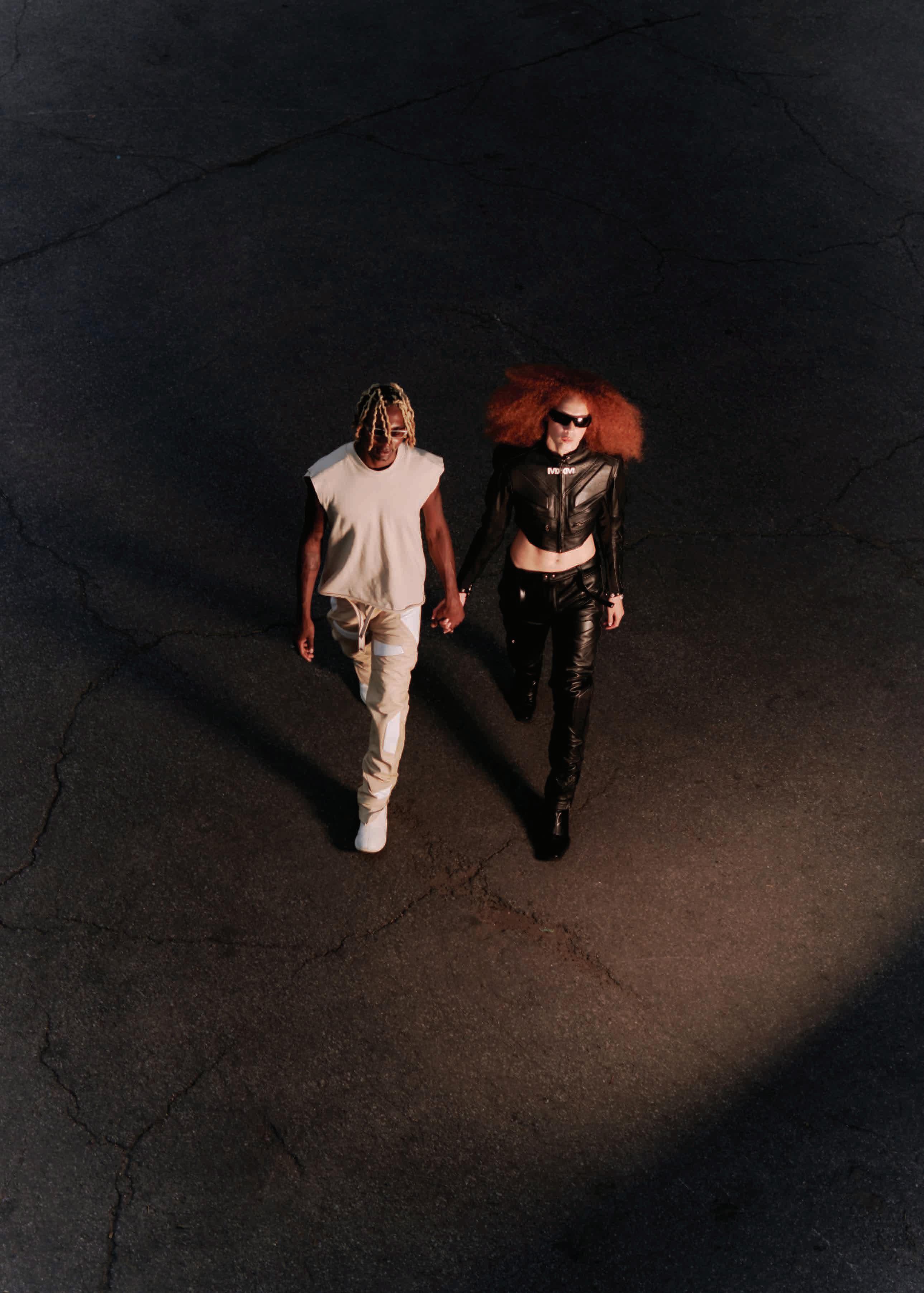












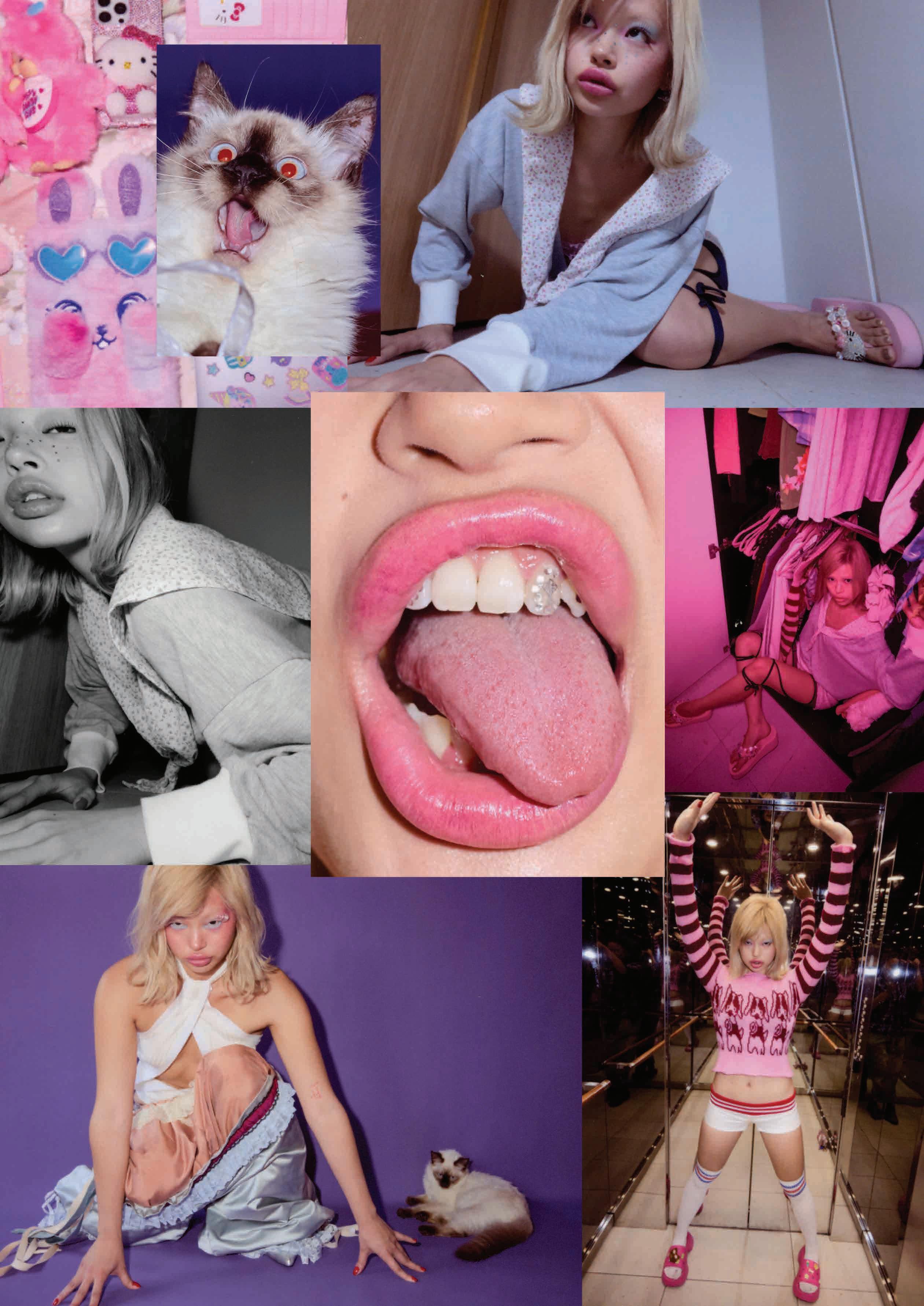




CALLI COMICAL
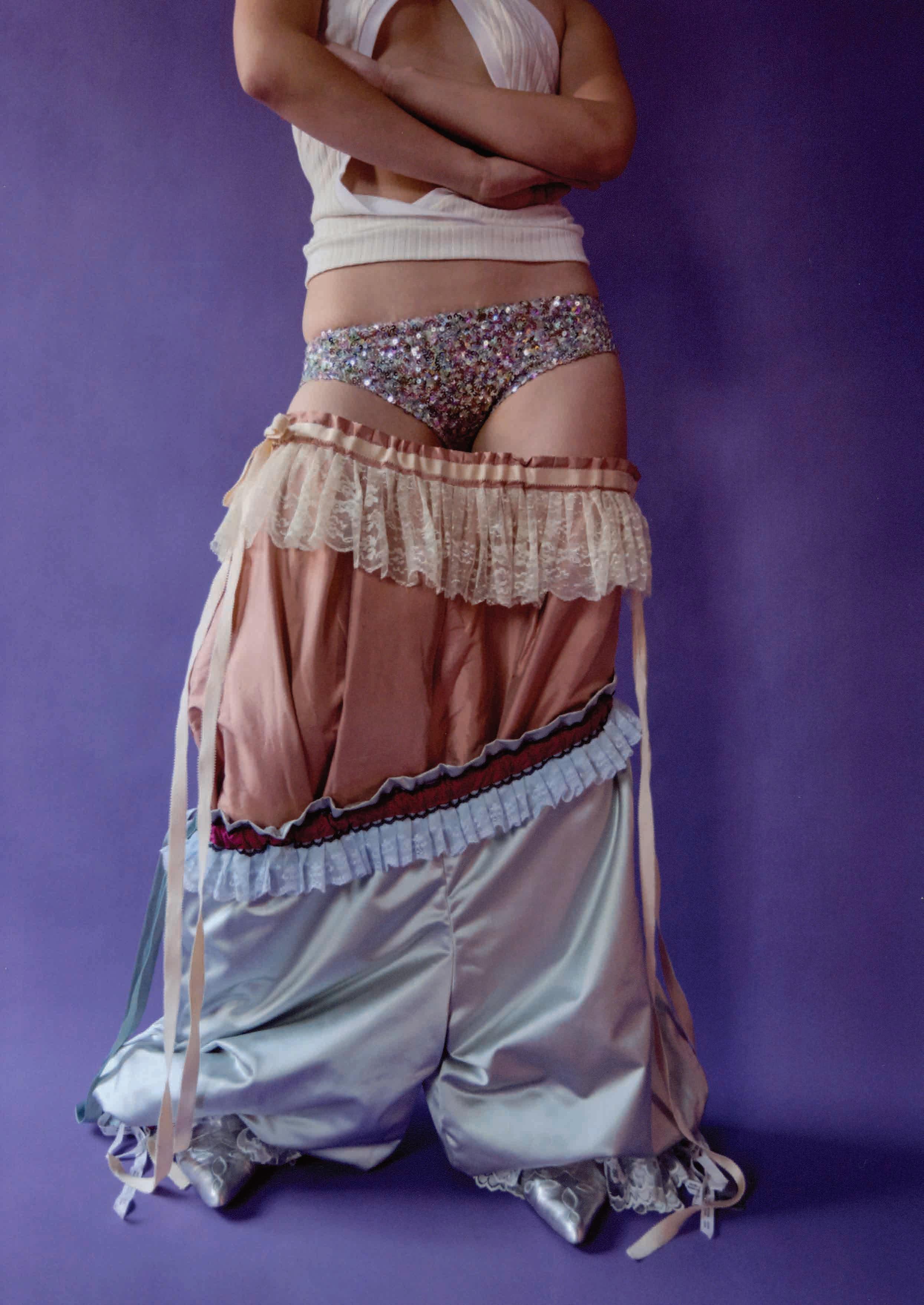


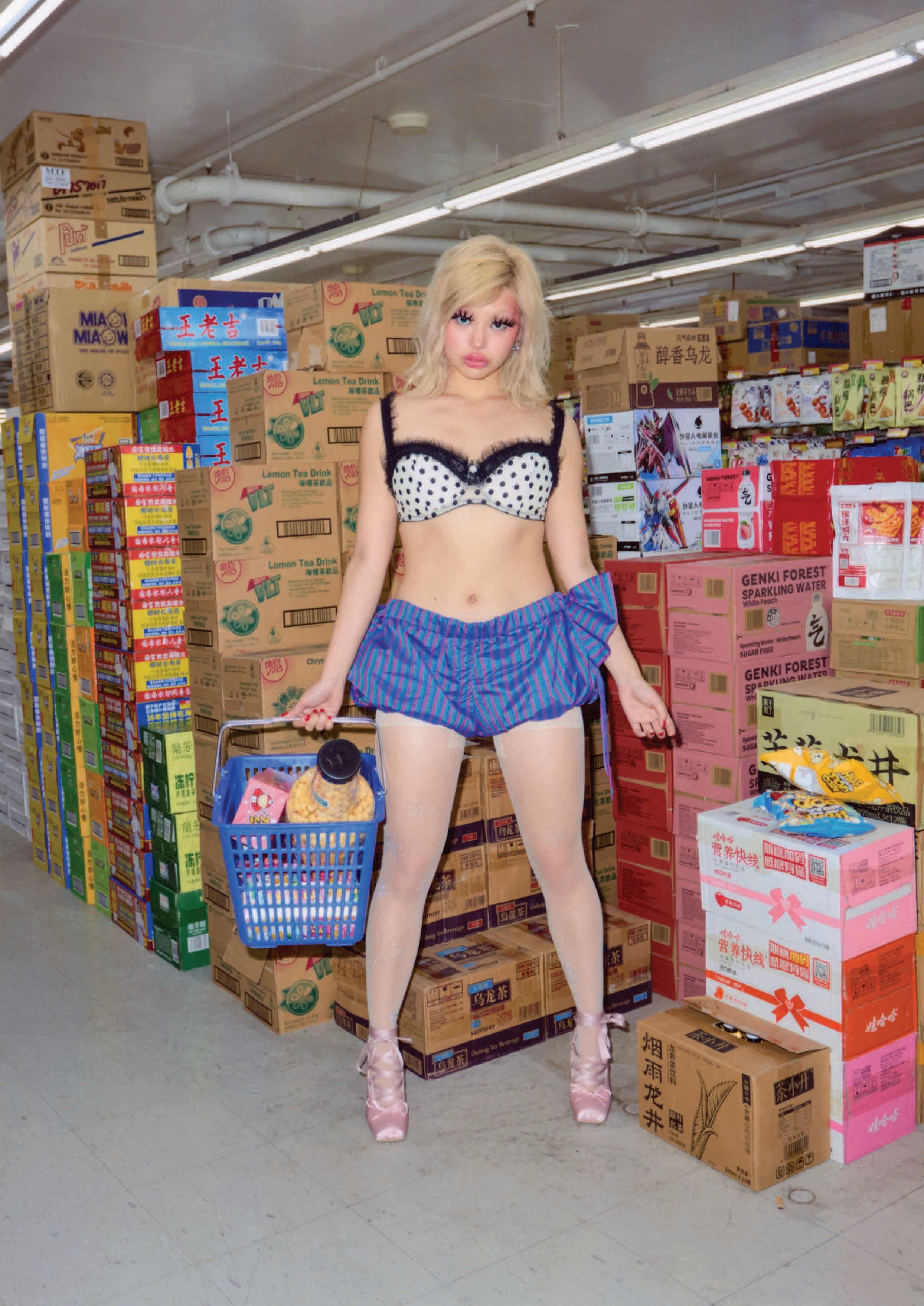
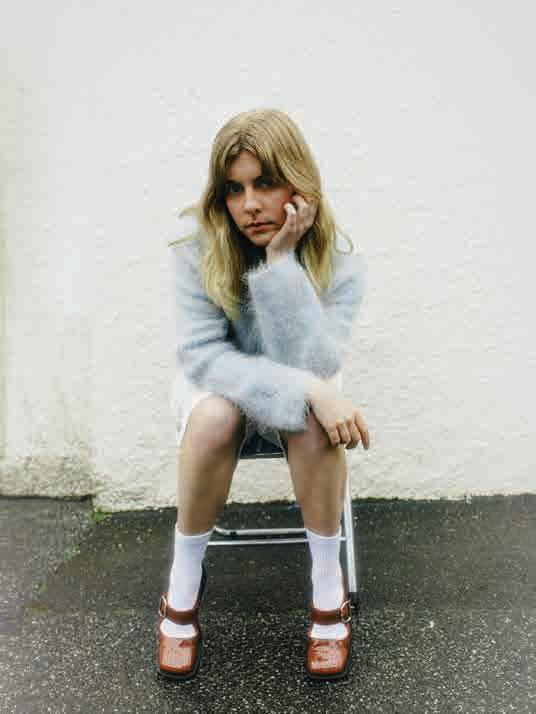
HENRY
There’s nothing quite like the feeling of discovering a new artist who just speaks to you. It can be rare, so when it happens you go all in, spending the afternoon bingeing their entire catalogue and taking control of the AUX any chance you get. Locally, there’s no shortage of incredible new music if (like us) you’ve been looking for your next fixation. Take Loose Content, the three-piece indie rock band from Byron Bay whose upcoming single, ‘Where the Hollow People Sleep’ will win you over from the first listen. If hip-hop and R&B are more your thing, Squid the Kid’s debut EP, Kozy Tape, is the experimental, feel-good soundtrack to carry you into summer. Then there’s Juice Webster, the Melbourne-based singer-songwriter who blurs the line between folk and pop. Fresh off the back of her album, Julia, her sound is immersive, dreamlike and constantly evolving.

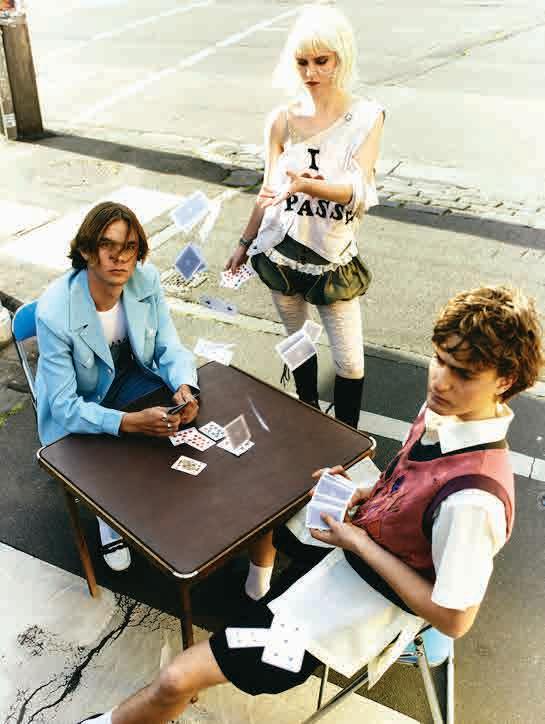
How do you approach songwriting as a band? Does everyone have separate roles or is it a collaborative process?
MiLLa (vocalist and bassist): It takes various forms… One of us will come up with a riff or a chord progression, or just a general idea, and then we’ll take it to the rest of the band and we’ll build it from the ground up together. Then lyrics will be added following that process. Or it might [be] the other way around, where it starts with a poem or some kind of thematic inspiration.
Sam Sanders (guitarist): It’s always finished together, but sometimes it starts out more separate.
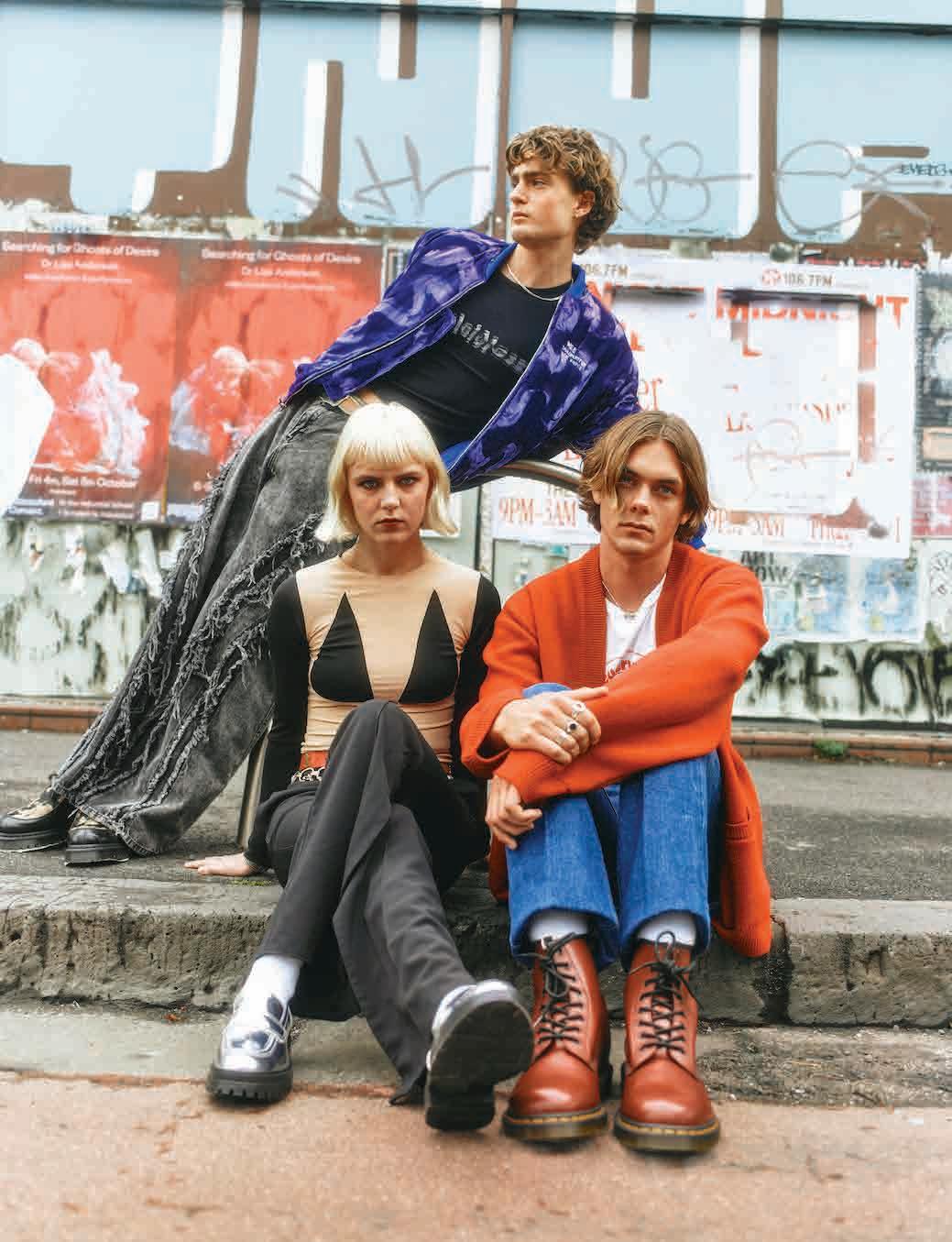
What’s your favourite thing about performing live?
S: Sometimes it’s the feeling that it could all fall apart. Obviously, we know we can play these songs, but how much [can] we push it until it goes wrong? But also, when it goes wrong… that’s the best part of playing live.
M: It’s one thing to go and record songs. It’s another thing to be on stage and to all be experiencing that together – not just the people who wrote the song, but strangers, people you’ve never met before, all being in that experience together. We have big goals of touring with an orchestra or a choir – to have more people with us on stage, and having
brass, and really amplifying the sound and bringing it to a new level.
What do you want people to feel after hearing ‘Where the Hollow People Sleep’?
M: A curiosity. Or a compulsion to wonder about the different parts of their own mind, the different parts of their psyche.
What genres do you draw inspiration from?
Probably R&B and soul, mixed with a bit of funk and disco. That’s definitely my home base and what I’m known for. In terms of making [Kozy Tape], I really wanted to challenge myself and see what I could do with my songwriting abilities. That’s why you hear the different genres, variations and sounds throughout.
What music did you listen to growing up?
I’m not going to lie, I was raised on the radio. My parents didn’t really play
music throughout the house, so [I listened to] mainly pop records. That influenced my music in terms of the way I arrange sound and how I put things together.
How is Kozy Tape different from your previous work?
Up until this point, I’ve only released singles. So this being an EP with multiple songs was a big thing for me because I’m not much of a multitasker. It’s a different sort of grind, a different mode you have to get into when you start a project.
Also, the different genres on it. Apart from ‘Moves’, which is track number one,

everything else is different. You’ve got ‘Speed’, which is drill-inspired, and you’ve got ‘Stay’, which is UKG-inspired. So it’s very different to what I’m used to making, or what I’m known for making.
What was your favourite part of making the EP?
Honestly, just staying locked in. It gave me a routine, it gave me a bit of discipline. I put a lot of pressure on myself, which is not a bad thing. Being able to go into the studio pretty much every day and setting a time limit and working from, like, 12 to six, it gives you something to work for. It gives you a sense of purpose.
Who do you create music for?
Anyone who wants to listen to it. What I look for in music is when someone explains something that I haven’t been able to put into words before. I guess, ideally, my audience might be in that same boat.
What’s your favourite song that you’ve written?
I would say ‘Returning’. Lyrically, it makes me feel something every time I play it. It’s one of those songs that fell out of me. It sounds cheesy but it’s taken

me a while to figure out exactly what it’s about because I think it’s about so many things. The lyrics in that song are abstract but also mundane, “I like my hair the best when it’s wet.” [There’s] something about that line – there’s a real imagery to that –and it’s also just true.
Are there any key ingredients you have for songwriting?
I haven’t figured that out yet. Sometimes it’s the hardest thing in the world, in a way that feels really rewarding when we get to the other side.
But sometimes, you’re in this space where something rolls out. I find [when that happens] it’s usually because there’s a feeling brewing, or there’s something that I can’t work out, or that’s been on my mind a lot and I need to get off my chest.
Words by Maggie Zhou
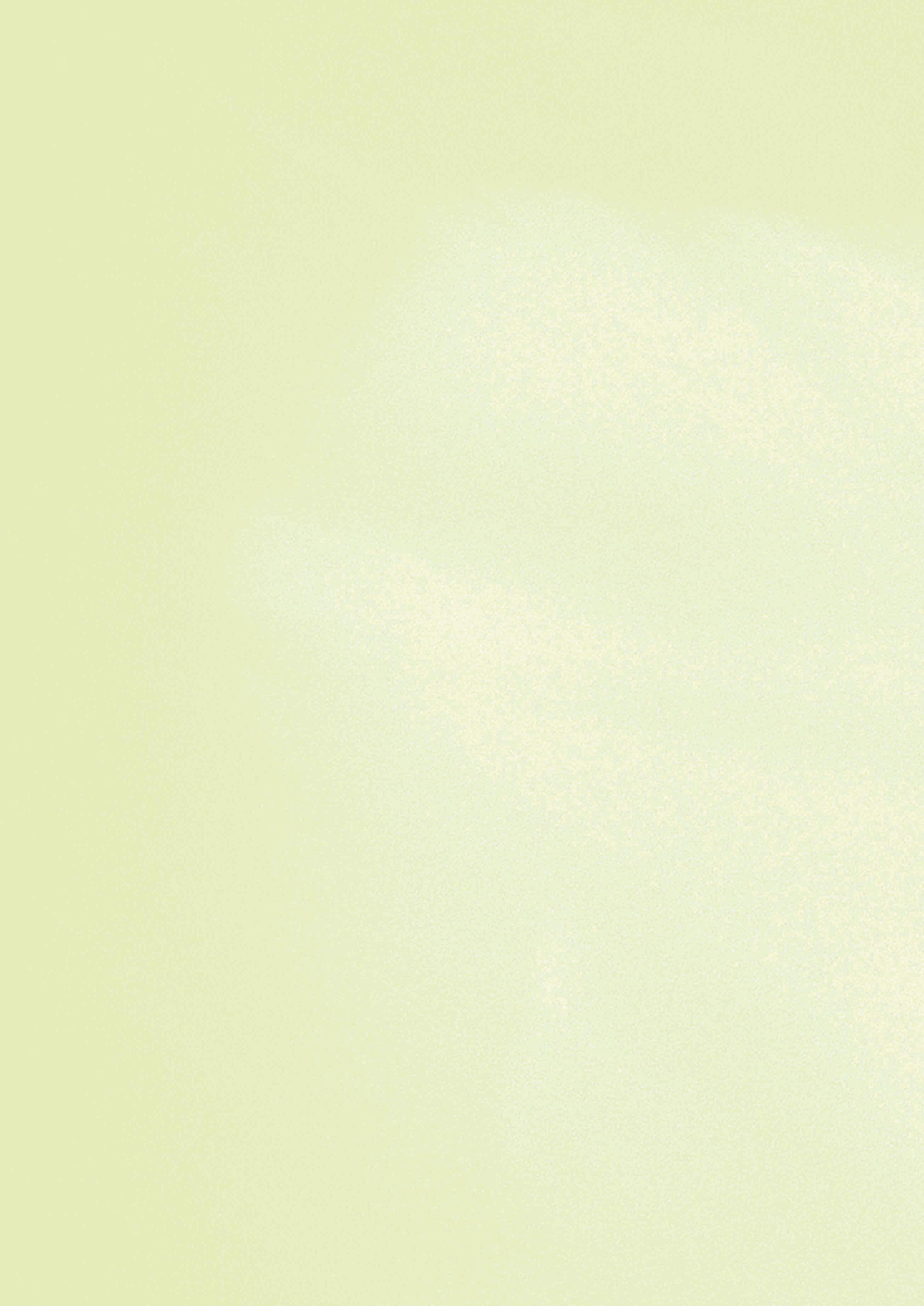
A few years back, a friend of mine and Fashion Journal contributor, Ruby Staley, wrote about the joy she felt after moving up a dress size. “Life-changing,” she called it.
The piece went somewhat viral on Fashion Journal and has been shared a number of times since. Something about countering the narrative we’ve all been fed, that there’s some secret shame in moving up a size, really resonated.
“Clothes are to be enjoyed,” she wrote. “They should be a source of delight and self-expression or at the very least, they should be functional, comfortable items to cover our bodies. Nothing more and nothing less.”
It was the first time I’d heard someone speak (or in this case, write) positively about sizing up. Ruby sized up after her
petite gymnast body grew in her final years of high school, but there are many other reasons a person might need to shift a dress size. For everyone, though, it involves the process of trying to accept your body, wherever it falls.
Holly Richards is the founder of AmpleFolk, a Melbournebased size-inclusive apparel and lifestyle label. At 36, she admits she hasn’t reached a stage of weight contentment and probably never will, though every day she’s inching closer.
AmpleFolk was created in response to the standard sizes of bath towels – a product you’d expect to fit all bodies but sometimes doesn’t. AmpleFolk broke the mould by offering plus-size towels that fit up to a size 34.
The label’s ethos mirrors Holly’s relationship with weight. Instead of getting frustrated with her body when clothing doesn’t fit right, she tries to shift that irritation onto the garment itself.
“Part of that acceptance has completely freed me from worrying about the size tags in my clothing,” she says. “I definitely think there’s joy in letting those things go –removing even some of that shame makes room for joy.”
For 35-year-old Melbourne local Tully Walter, sizing
up meant prioritising the health of her body after years of “glorifying busyness” and a decade of dysfunctional habits. When her period stopped altogether, she sought the help of a GP, who found she had significant vitamin deficiencies.
“I started learning about nutrition, eating consciously and, above all, prioritising my health in the way I would’ve formerly prioritised work deadlines. On this journey, I also sized up a couple of standard Australian dress sizes.”
It’s refreshing to hear Tully speak about her upsizing as a byproduct of her improved health, rather than the most important thing. It’s refreshing because weight gain is so often wrapped in shame.
If anything, her sizing up is accompanied by a dose of pride. “I feel so proud of my now-healthy organs, particularly my cyclically restored reproductive system. I imagine them now well-fed and thriving in their new comfy doona!”
For Sydney-based comedian, author and presenter Lucinda Price, weight gain went from being her “worst nightmare” to something that now feels “totally neutral”. It’s a big feat for someone who’s recovered from eating disorders, an experience she writes about in her memoir, All I Ever Wanted Was To Be Hot.
A longtime lover of fashion, Lucinda had developed some fixed ideas around the relationship between size and personal style, something she had to untangle as she started to recover and gain weight.
“A friend of mine said, ‘When you were sick, you weren’t wearing the clothes, the clothes were wearing you.’ That really stuck with me and helped me let go of the idea that I needed to be a certain weight to be stylish and enjoy getting dressed… I see style now as a skill that can be honed.”
Lucinda’s love of fashion remains unwavering and she says her eating disorders didn’t change that. “I don’t think your style has to change drastically when your body does. I think there’s power in wearing the same style of clothing you wore at a smaller size. This is easier said than done, of course. Lots of clothes only go up to a certain size.”
While away on a university exchange in 2020, 27-year-old Ying dropped a couple of dress sizes. At first she was pleased, attributing the weight loss to a high step count and figuring

she’d be able to fit a new pair of jeans that were a bit too small.
Sadly, a lymphoma diagnosis followed, along with an unexpected side of guilt. “It was only later on, when I finally found out about the diagnosis, that all the pieces clicked in together, and I felt really guilty for feeling so pleased about the weight loss,” Ying tells me.
A couple of years into remission, after she’d gained back her weight and then some, Ying realised she was two sizes bigger than before she had cancer. She began slowly building a new wardrobe.
“It felt trivial to have even thought about [weight] so much,” she says. “It’s been a sense of, ‘Well, I’m just glad to be alive at this point and my body’s carried me through this really horrific, traumatic process.’”
Naturally, our bodies change with us as we age. For FJ contributor Tiara Swain, this hit home when she became pregnant with her first child. Her growing belly meant she wasn’t able to fit into her mother’s and grandmother’s handme-downs, but an unexpected joy of sizing up was being able to wear her partner’s clothes.
After one particular meltdown about her wardrobe which left her dreading going out, Tiara’s fiancé offered his clothes as an option. Since then, she’s been living in his T-shirts and sweatshirts. “What began with some frustration towards weight gain has evolved into a deeper appreciation for the incredible things my body is doing and an unexpected connection through my partner’s wardrobe,” she says.
Looking to her postpartum future, she feels content. “I may not fit into everything I wore before, but I’m excited to discover a new style that makes me feel confident and comfortable as a mother.”
Terms like body positivity and body neutrality aren’t always enough to cover our complicated relationships with our bodies. Many of us exist in the grey area in between. Sizing up doesn’t have to be something that’s overly celebrated if you don’t want it to be, but it doesn’t have to be something that’s vilified, either.
As for Ying, “I still keep coming back to this idea that, well, my body’s seen me through a whole bunch of shit, and I’m just grateful for having gone through it. If this is the body I’m in at the moment, I’ve got to love it, I’ve just got to be grateful for it, and carry on.”
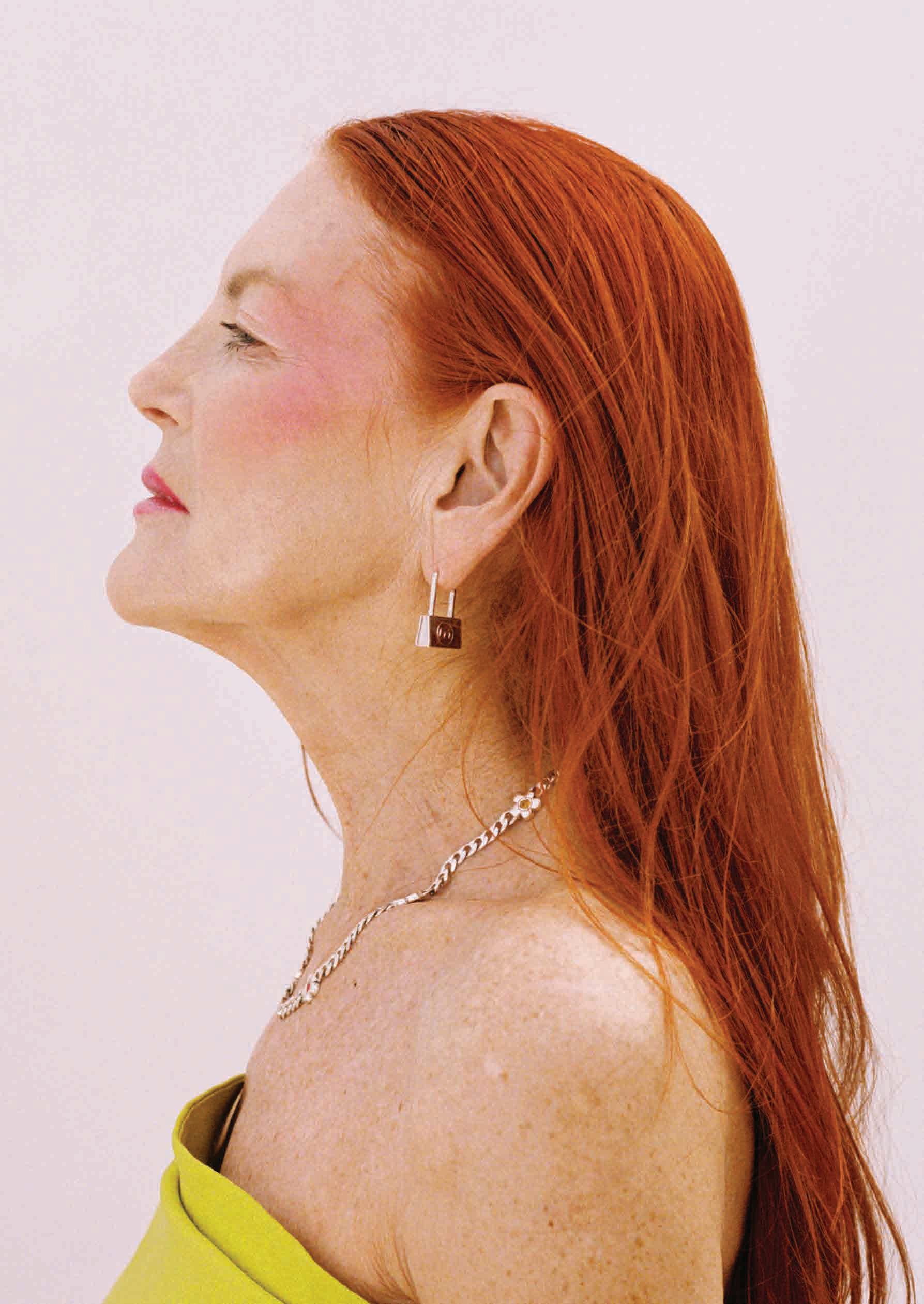

Cheeks
Bisou blush in Inès and Mélanie On Lips HALF MAGIC Sculptitude longwear lip liner in Up and at Em, QUESTION BEAUTY lipgloss in Magenta Florals
27MOLLYS Shopping Bag earrings and Flower Chain Multi
On Eyes L’ORÉAL PARIS
Colour Queen eyeshadow in Ruthless
On Cheeks WESTMAN
ATELIER Super Tinted
Loaded Highlight in Peau de Pêche
GRAEDANCE Firo earrings, 27MOLLYS bracelet, Stylist’s own top and bikini
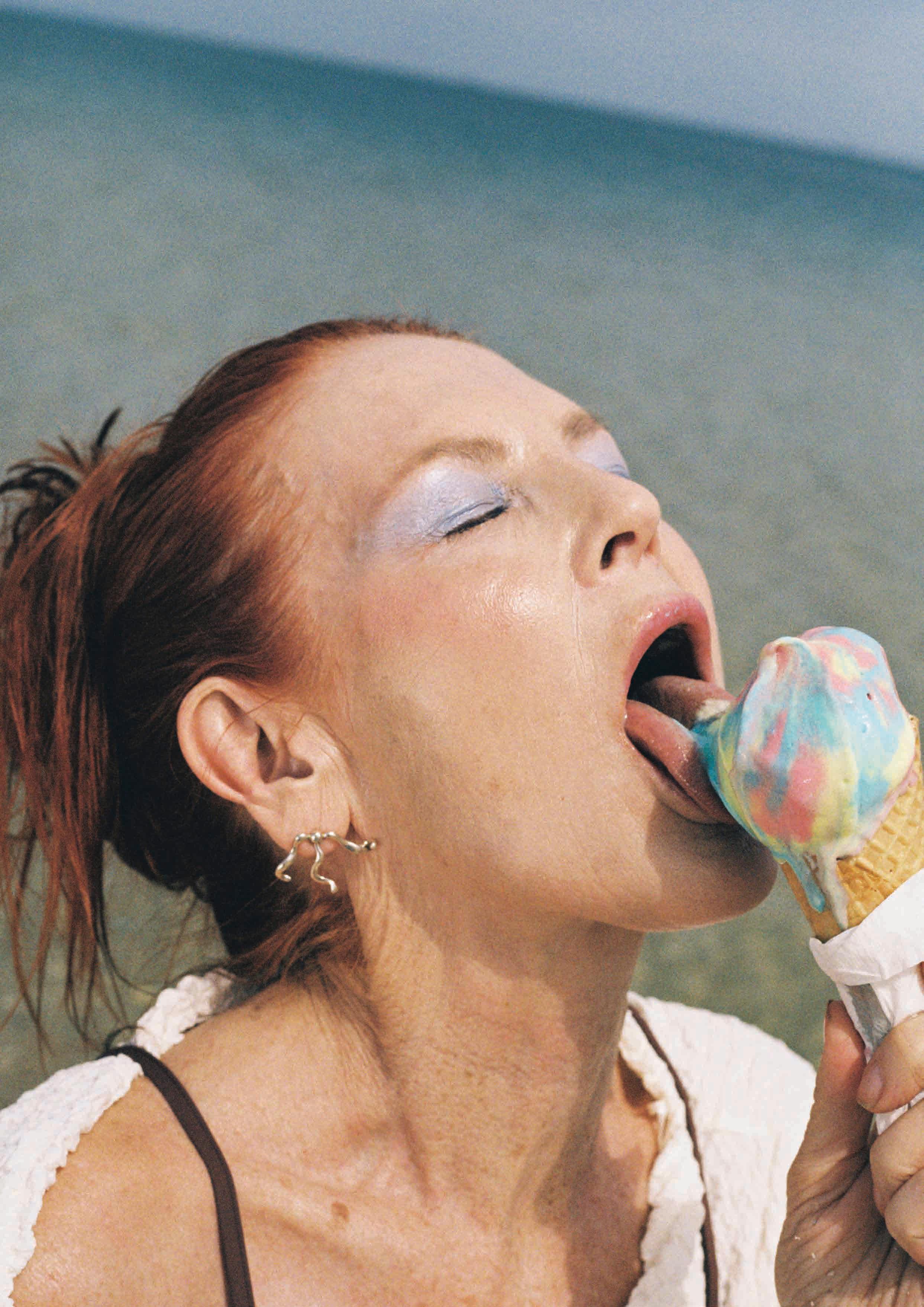
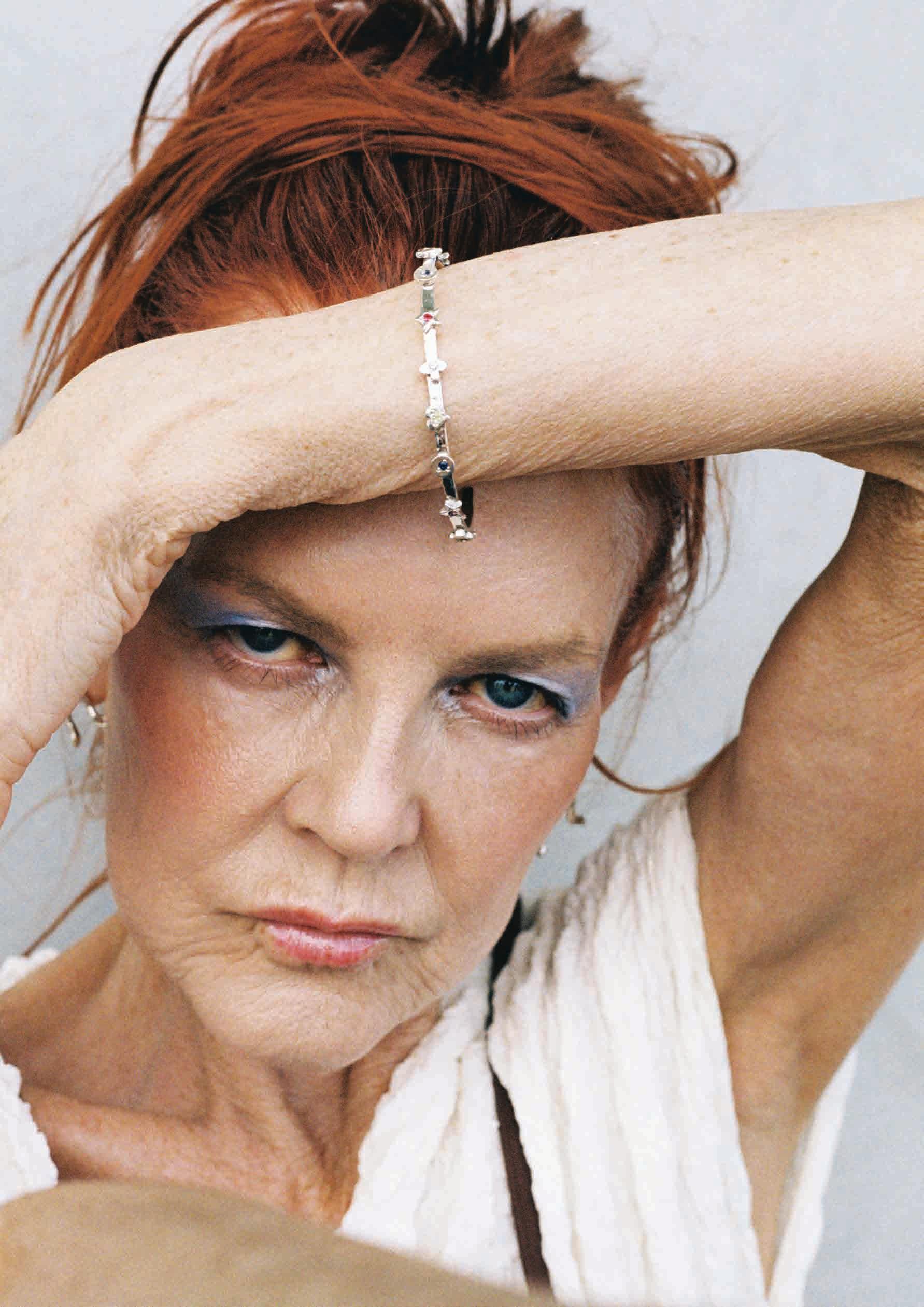

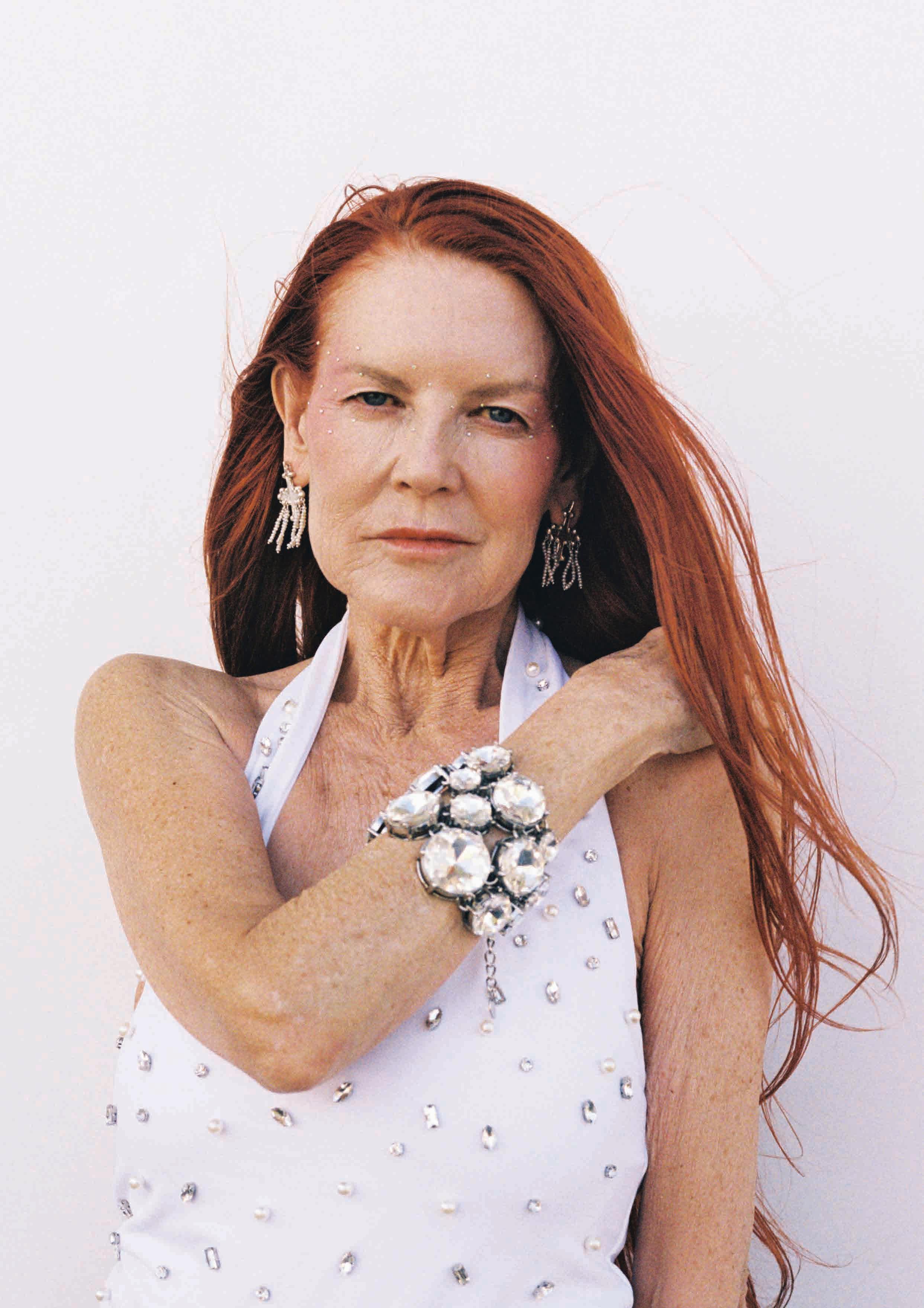
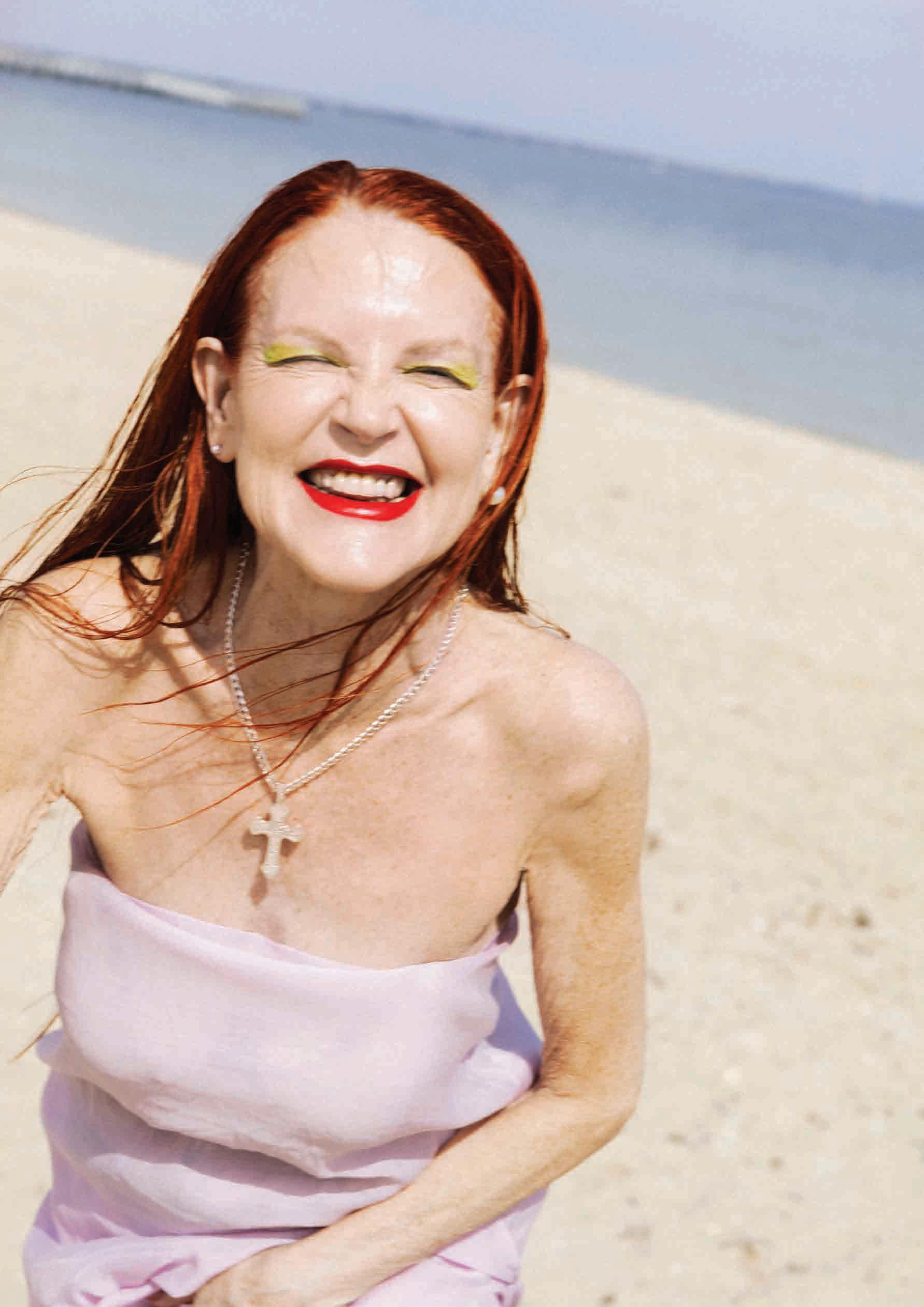
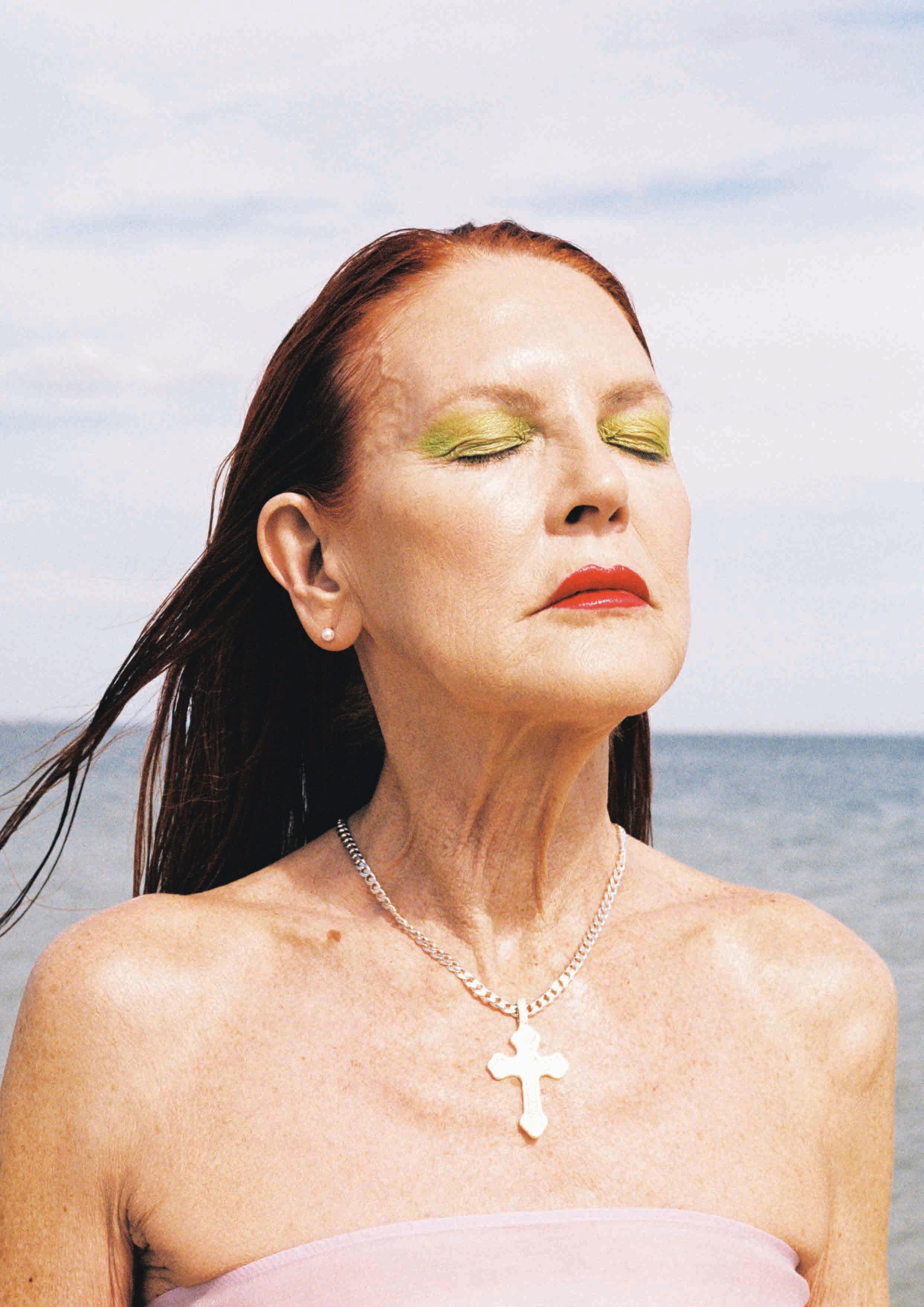
Words
by
Collage
Erika Geraerts
by
Nina Abrahams

The founder of beauty brand, Fluff, reflects on beauty, ageing and intervention.
I opened Instagram the other day to see a news piece all about the rise of ‘baby Botox’, which I quickly realised is simply another way to talk about ‘preventative Botox’. I felt deflated. Did I feel this way because both ‘baby’ and ‘preventative’ Botox are simply Botox rebranded, and I think marketing should be smarter? Or because I think women should be smarter and stop convincing themselves of the idea that ageing can be ‘prevented’?
At times, I feel like I’m living in my favourite ’90s movie, Death Becomes Her, a dark comedy about two rival women (Meryl Streep and Goldie Hawn) who drink a magic potion that grants eternal youth, only to face unforeseen consequences as their bodies decay despite their immortality. It’s a theme revisited in this year’s divisive release, The Substance, which follows an aerobics instructor (Demi Moore) in a desperate pursuit of youth. Both are grotesque, slotting into the particularly visceral body horror genre. It’s art imitating life, taking our cultural obsession with beauty to the nth degree. Both pivot around the same central question: How far will we go to look beautiful?
As a founder in the beauty industry [editor’s note: Erika's brand, Fluff, sells vegan, refillable makeup and skincare], most days I have to remind myself that choosing not to participate in what I define as oppressive beauty culture is important; a value and a legacy that I want to share.
Beauty standards are constantly shifting. They’re rooted in religion, politics, gender, class, capitalism and so much more. They reach almost every facet of girlhood and womanhood, dictating what we wear, how we speak, how we move, what we eat, even how we sleep. And yet what concerns me most is our desire to freeze time.
Ageing has gone from something inevitable to something avoidable, or at least, we can pray (and pay). But at what cost?
Recently, I published an article talking about how I’d found myself in more conversations than I’d like around Botox. “I’ve never had an issue with getting older,” I wrote. “But I’d be lying if I said I didn’t notice looking older. Not just at beauty events, but day to day – at the cafe, in my yoga class, at run club, the grocer, on a plane. I continually find myself surrounded by women who look five to 10 years younger than they are. Next to them, I look tired. Ironically, when I speak to these women,
they feel tired, except I can never tell, because they’ve frozen their faces in time.”
“I am against Botox,” I wrote. “And while one day I may eat my own words, I really hope I don’t.”
I shared this piece on the Instagram account of my beauty brand, Fluff, and it was one of our most engaging pieces of content ever. Clearly, it struck a nerve.
There are many reasons why women choose to have interventions like Botox and many reasons why they choose not to. I’ve discussed these at length with many people, particularly through Fluff’s podcast, Pretty Hard. These conversations have been vulnerable, illuminating, inspiring and disheartening. I’ve been compiling these thoughts into a book, which I hope to release one day.
“It’s a protection thing, I want to be guarded for the future. When it comes down to it, it’s probably an anxiety thing, wanting to make sure I can predict the outcome: ‘I won’t look old because I’m doing it now.’ But we know preventative Botox isn’t a thing, it’s just Botox.” – Lucinda Price, comedian, author and presenter.
“There is so much research coming out, and a movement against these procedures, because they’re not sustainable. The conversations are becoming deeper: ‘Why do we need to preserve our youth?’” – Stacey Burt, founder of holistic skin clinic, Little Company.
“I went so hard on the injectables and I’ve had such a break from that, that my face looks like mine again.” – Erin Deering, designer at Deering World.
Of course, I’ve thought about getting Botox. Likewise, I’ve thought about lip fillers, the ‘triangle of sadness’ that crinkles between my eyebrows, and the pigmentation on my forehead. I’m subject to continual, internal struggles. I grapple with the face I want to present to the world and what I think I should present – particularly given my platform within the beauty industry.
“But then I’ve thought about looking like everyone else,” I wrote. “About getting rid of the signs of joy, stress, struggle, hard work and summers well spent. I’ve thought about denying
myself the opportunity to see what I look like over time.
“Ultimately, the thought of Botox has never made me feel good or empowered – two words I often hear from the other side of the fence. The idea of Botox has only ever made me feel the opposite, like I’m not enough, not powerful or not desirable as I am.”
I get it, we all have the right to choose what makes us feel beautiful. And I don’t want to take that away from anyone. But I also want the right to question what makes me feel beautiful – the systems, the structures, the brands, the individuals, the media and more.
I want women to accept and acknowledge they are conforming. Whether you view that as a good or bad thing, that’s up to you, but it is a fact, just like we conform to other beauty and fashion trends. As a woman, we’re told (in the eyes of Western society) that we will be less desirable, ‘invisible’ if you will, as we age. We’ve been conditioned over decades to think that our value is in our looks, and we can’t be blamed for wanting to preserve this as much as possible.
But I am ever curious about the vivacious women who refute this idea – women like Michèle Lamy, Patti Smith, Diane von Furstenberg or Carol Green, the model for the beauty shoot in this very issue. I’m not talking about ‘pro-age’, silverhaired models who are 50 and hired by advertisers to present as 70. I’m talking about 70 and 80-year-old women who have chosen to embrace each stage of life, rather than deny it.
Happy feet and sun kisses
Why is it that we look at our mothers or grandmothers and love their lines, but not our own?
“I feel that I have lived every single day of my life,” Dianne von Furstenberg said last year during an appearance on Julia Louis-Dreyfus’ Wiser Than Me podcast. “In that life, in that short life, even though I am 76, I have piled up so much that I certainly could not feel any younger. I am who I am.
“That’s why I say, instead of asking, ‘How old are you?’ you should ask, ‘How long have you lived?’. And then, all of a sudden, you answer with pride.”
For me, living is enjoying it all. It’s drinking and eating in moderation. It’s being in the sun. It’s wearing sunscreen when I’m there for longer than 20 minutes but not on a winter’s day or indoors. It’s accepting my happy feet (which the beauty industry likes to call crow’s feet) and sun kisses (pigmentation), both natural outcomes that tend to follow the privilege and joy of having a baby. What incredible souvenirs these are of the changes our bodies endure and accommodate. And yet, so many of us try to remove these signs. But not freckles – we’ll draw those on with a pen because they’re cute.
Well, at least right now they’re trending, back in whatever year, we were concealing them.
Living is knowing what’s good and not good for me. I don’t smoke and I’m not into party drugs. I believe being outdoors, walking, meditation, therapy and yoga are not talked about enough, not only as self-care but as skincare. Living has meant I’ve accepted (despite a few moments of doubt) my thin lips –inherited from my mother, her mother. A reminder of where I came from.
I want to look my age
I wonder, what does a 35-year-old woman in 2024 look like? At least I can say she looks like me. I feel grateful that I’ll get to know what ‘me’ looks like today, tomorrow and over the years to come. I feel sad that some of my friends, and much of Instagram’s Explore feed, will not.
Of course, I’ve thought, ‘I’ve only got one life, so why not express and update myself to the max?’ But then I think about being my natural self, growing my hair out, not wearing any makeup at all. I think about the time when none of these interventions existed and none of this mattered. That time feels so much less stressful.
“Perhaps there’s nothing wrong with getting Botox if you’ve truly examined your why, and can be honest about succumbing to external influences and internal insecurities. But I think there’s something wrong with getting Botox when you start thinking about everyone else,” I wrote.
“I think there’s something wrong when your peers or children start looking at you, and wonder why their skin doesn’t look as plump or as tight or as clear, or why their nose doesn’t look as straight, or their lips as thick and full. I think there’s something wrong when you omit facts about your appearance. The cost of keeping up a lie is exhausting.”
To age is a privilege that not everybody gets to see out. Admittedly, our relationship to beauty and identity is pretty hard. I don’t know what I’ll be reflecting on and celebrating on my deathbed, but I have a strong feeling it won’t be Botox.

Some of the team at Fashion Journal share the little rituals they do before they leave the house for good luck (and good hair).
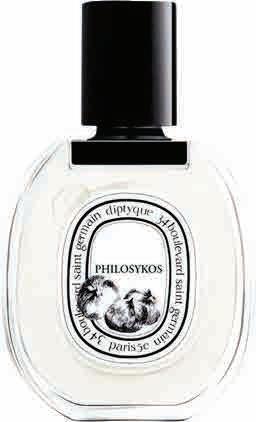
Apart from drinking my morning Berocca (my mum and grandma also have one every day, religiously), I give myself five minutes to do a few vital things before leaving the house. A quick zhush of my hair with the brush attachment of my Dyson Airwrap, attempting a swoopy thing with my grown-out fringe. A spritz of Diptyque Philosykos, which smells like a sun-ripened fig tree, and a kiss goodbye to my boyfriend, who is usually still asleep.
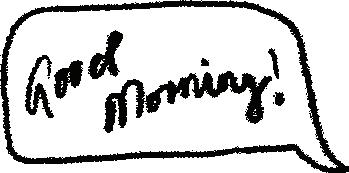



I have my departure down to a fine art. When I’m late (always), I pull my hair back into a bun and use the People Slick Styler to tie down any flyaways. I also use a little to brush up my eyebrows, and that’s my hair and makeup done for the day. I grab my Bichon bag which is always pre-packed, send a quick ‘Good morning!’ text to Mum and finish with my lucky charm, a gold ‘smiley’ pendant from Melbourne jeweller, Jake Cheeseman, which is my daily reminder to prioritise joy.
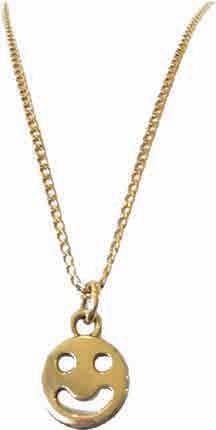

As I’m walking out the door, I do three things, otherwise my whole day will feel off. I brush out my hair and pop some Kérastase Elixir Ultime oil through the ends, I spray my favourite perfume, Yves Saint Laurent Libre, on my neck and only one wrist – I don’t know why I do this but it’s a superstition now. Lastly, I give my child (dog) Margo a treat so she doesn’t watch me leave, and tell her to have a fun day.


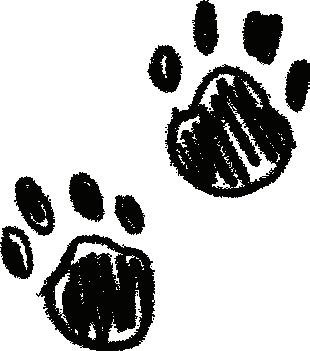
Though I’m often leaving in a fluster, I have three small rituals that I always need to do before dashing out the door, no matter how late I’m running. First, I’ll slip a Deiji Studios scrunchie on my wrist. Not only is it cute, but it’s a must when I get to the afternoon and need to tie my hair off my face. I’ll quickly roll on some Aesop Ginger Flight Therapy to a few pressure points and lastly, I’ll stop and ask myself ‘Keys?’ before pulling the door shut and accidentally locking myself out (again).



